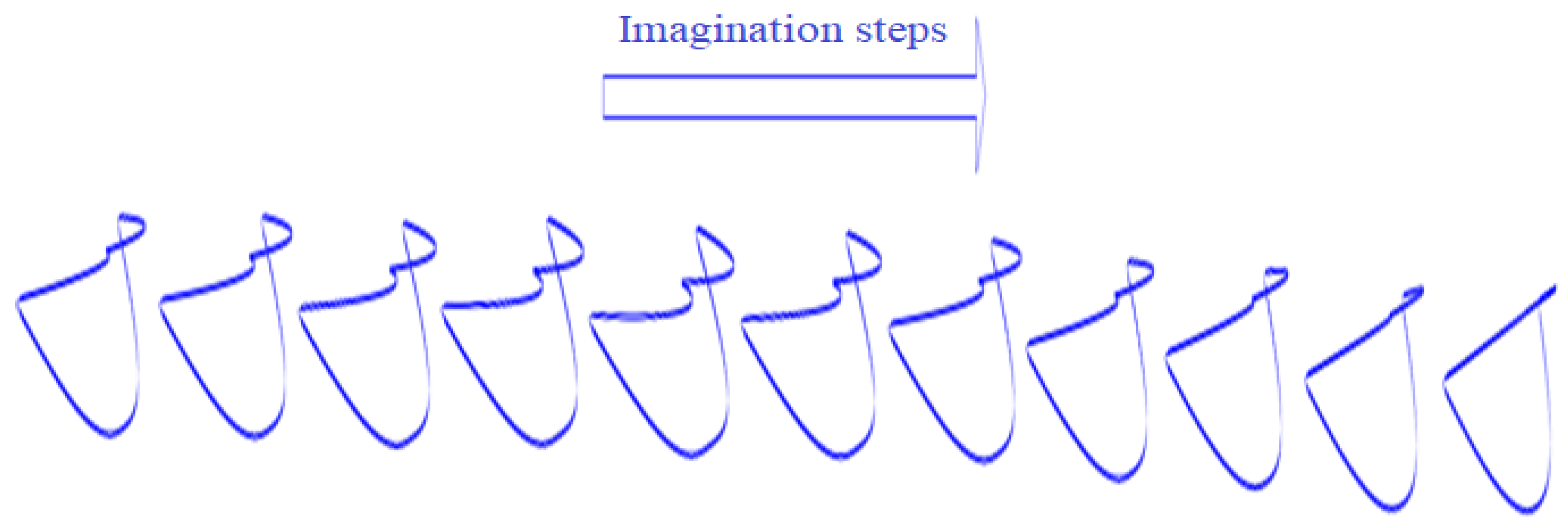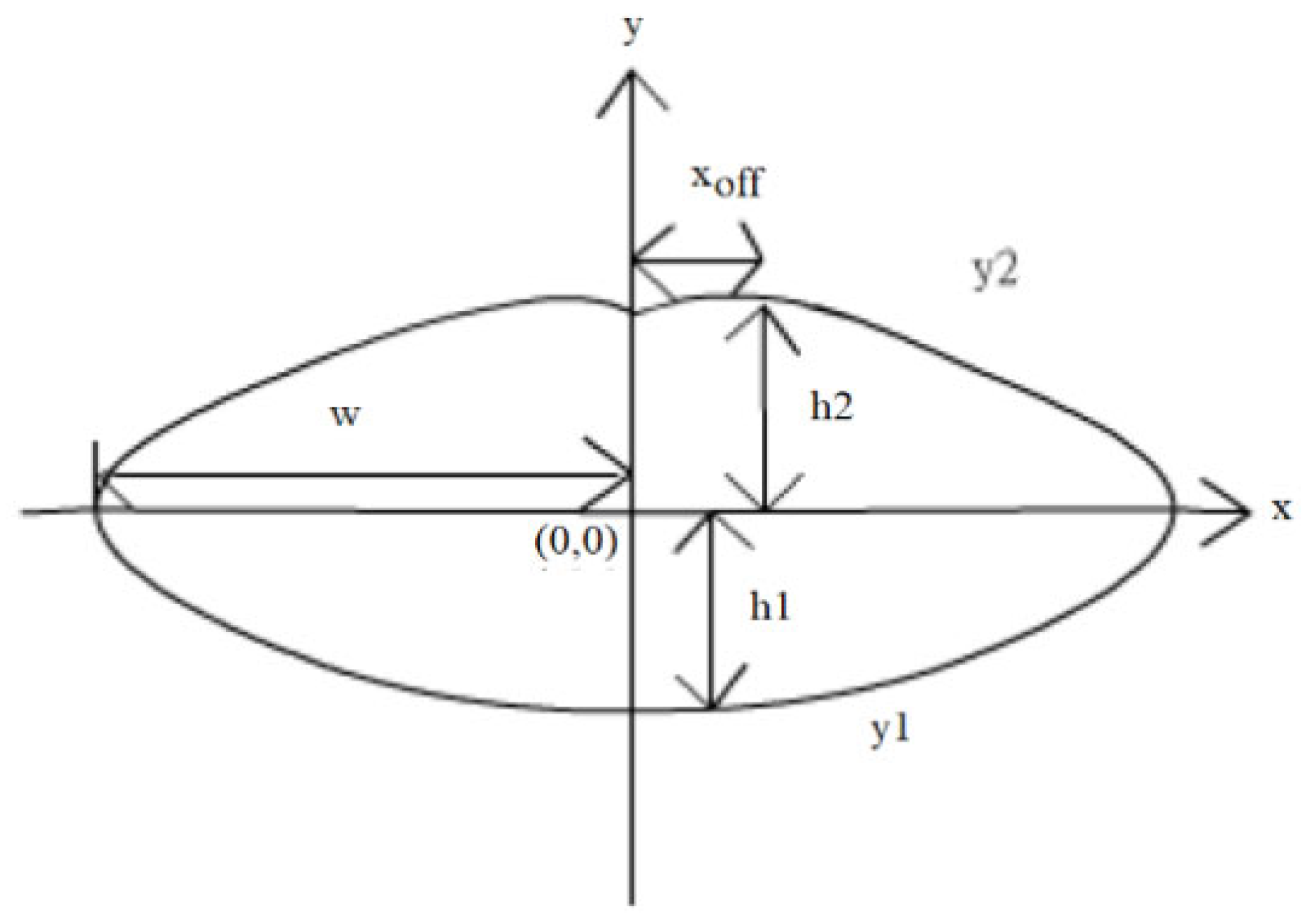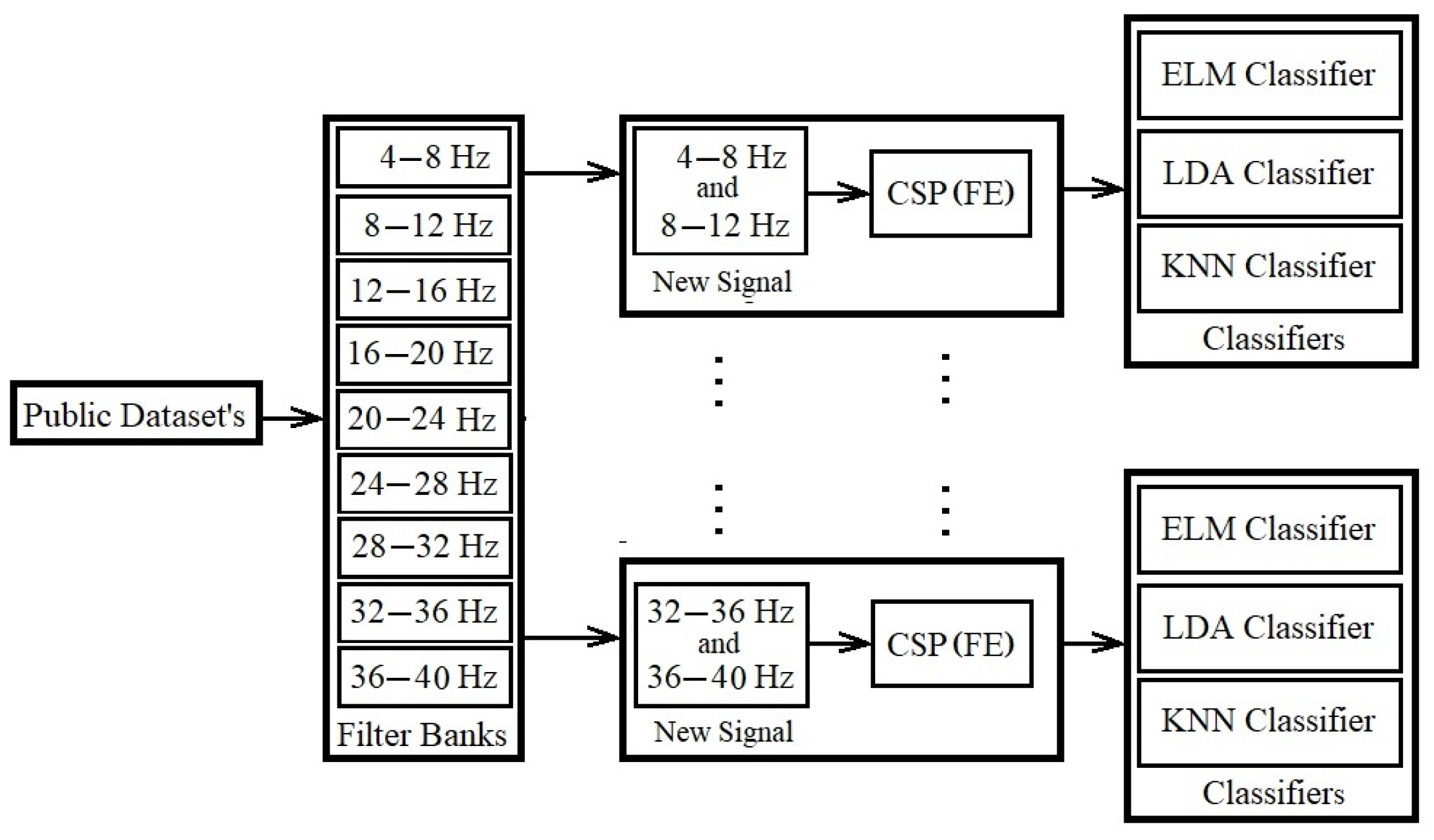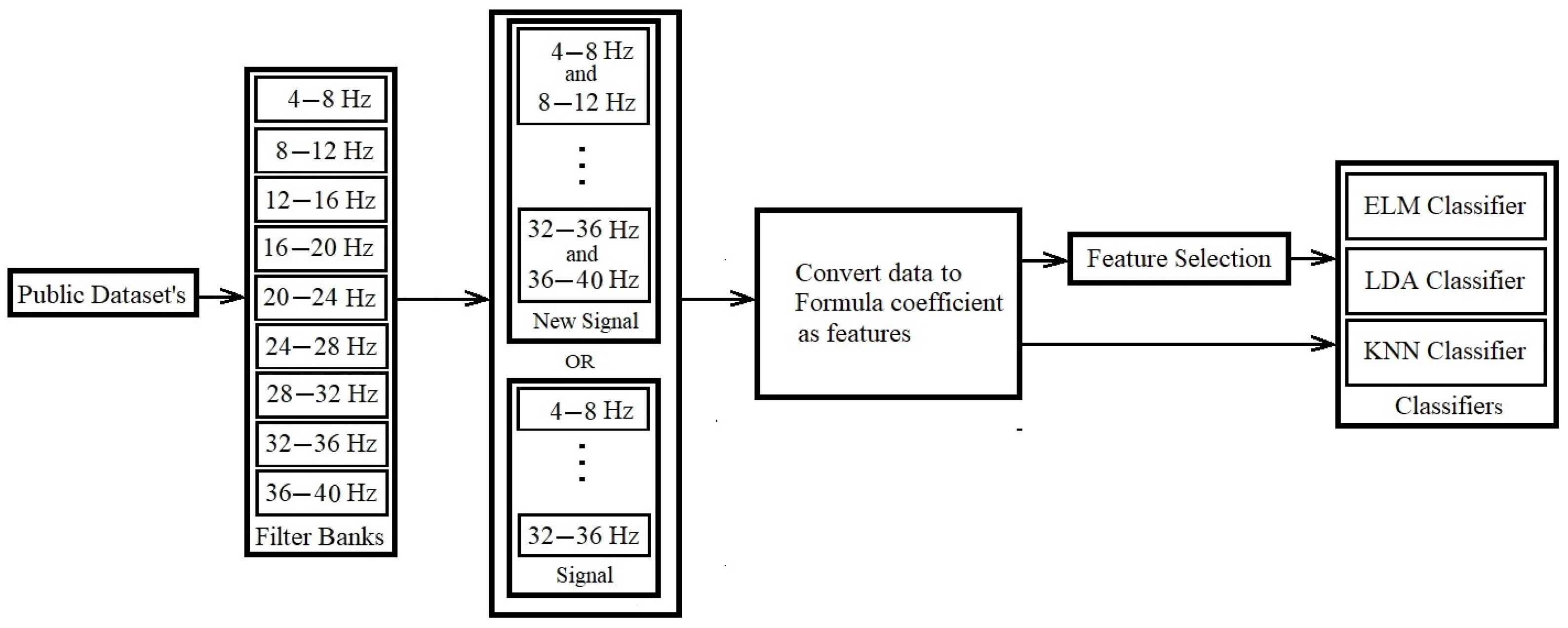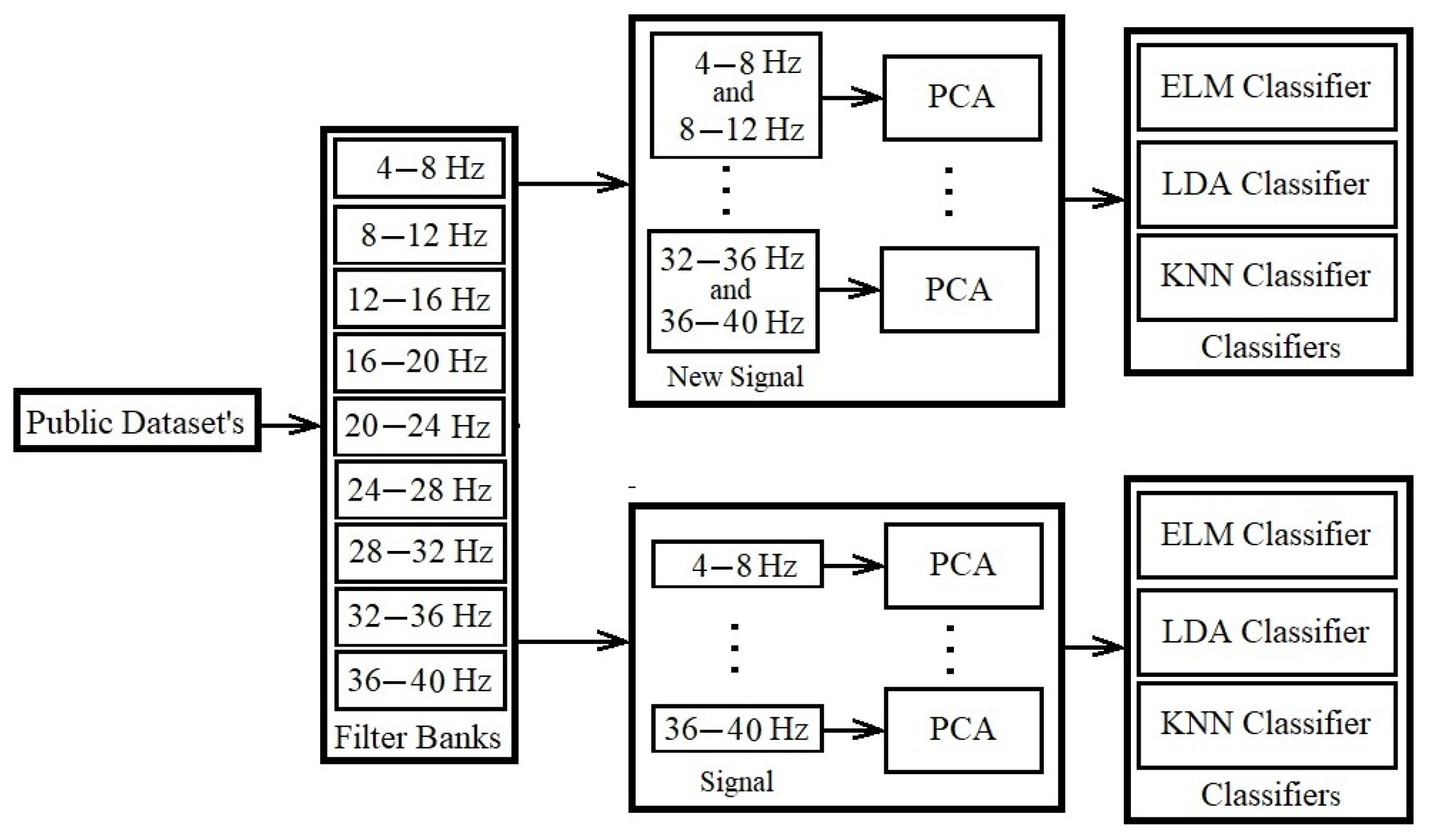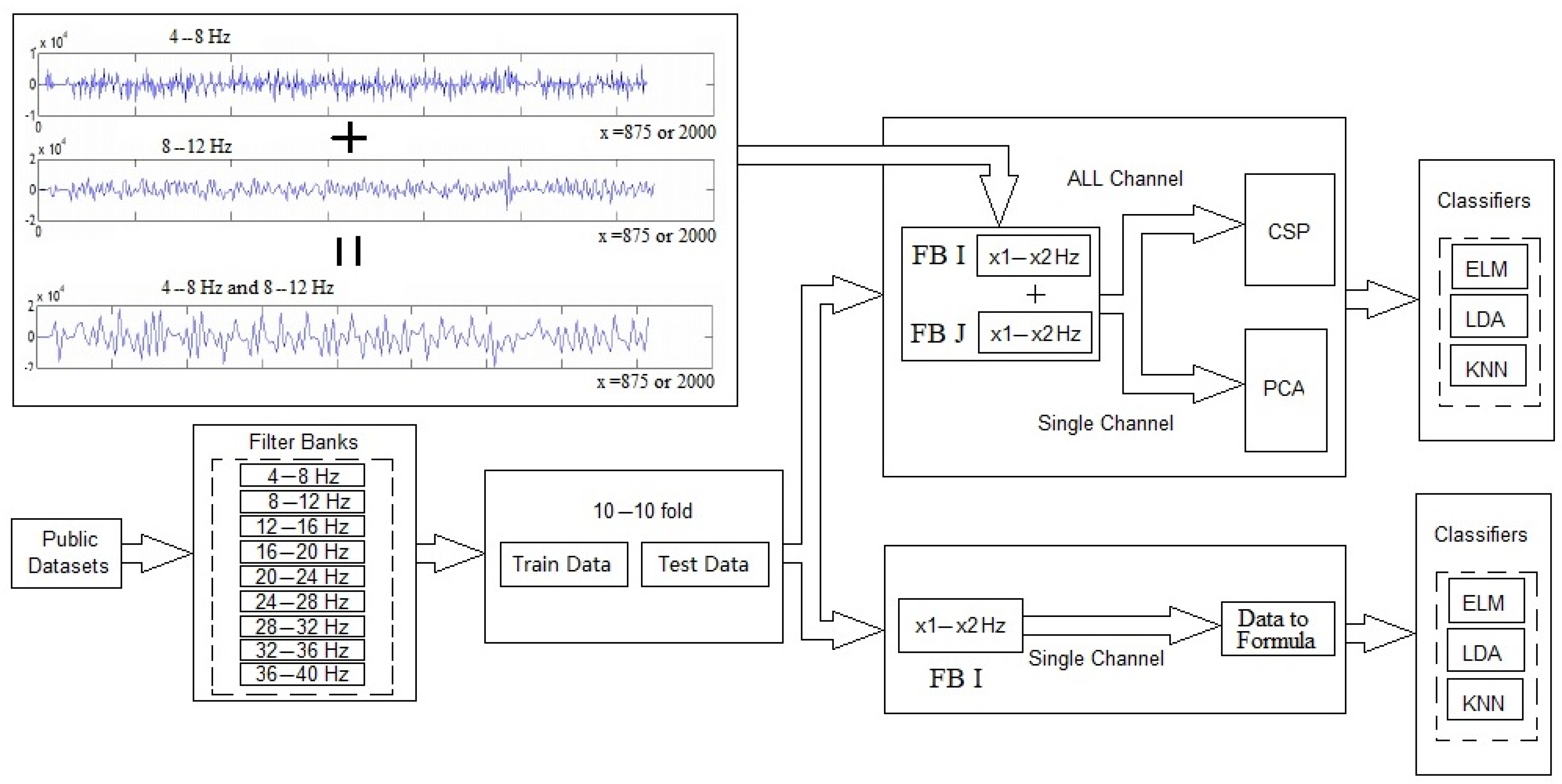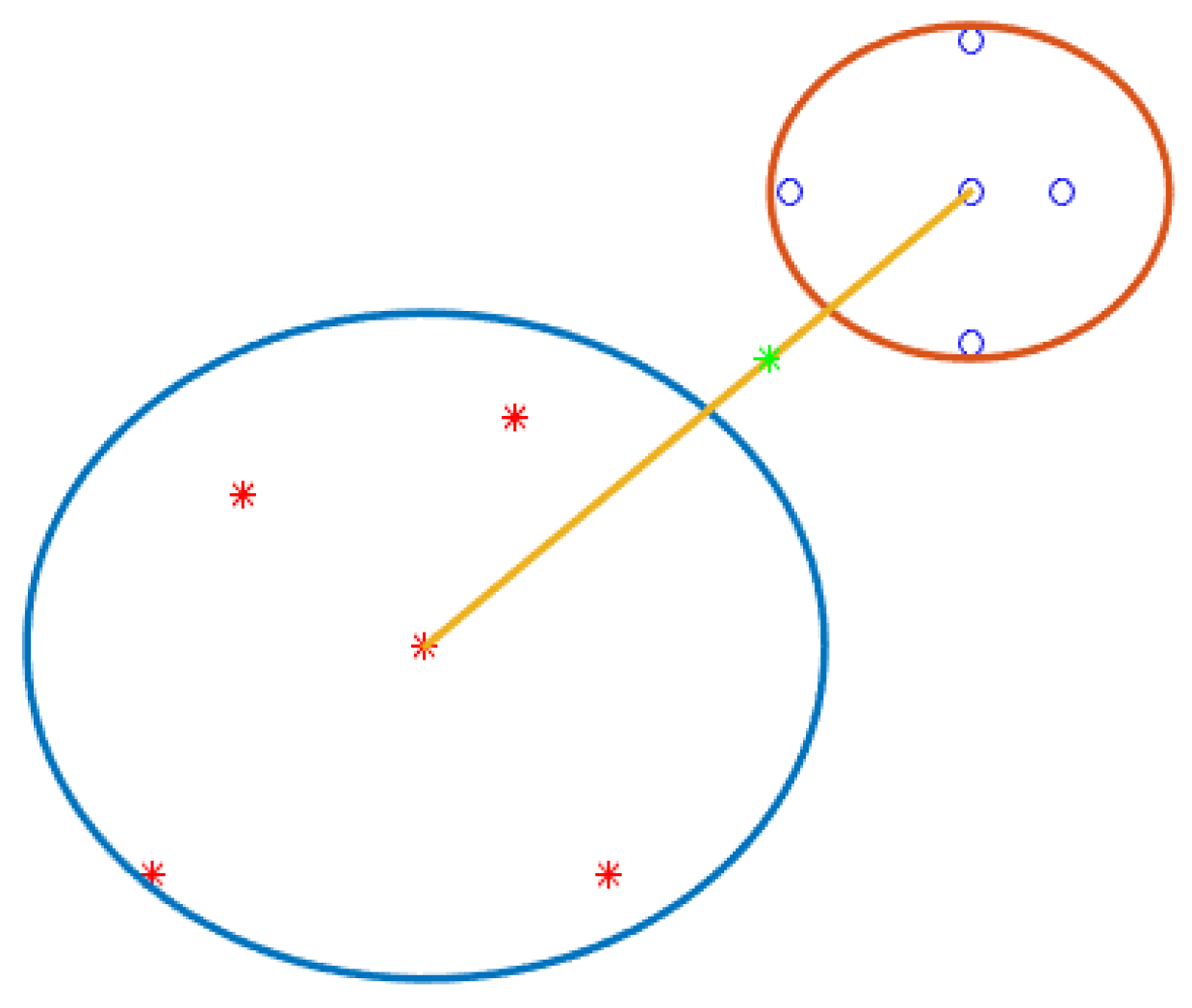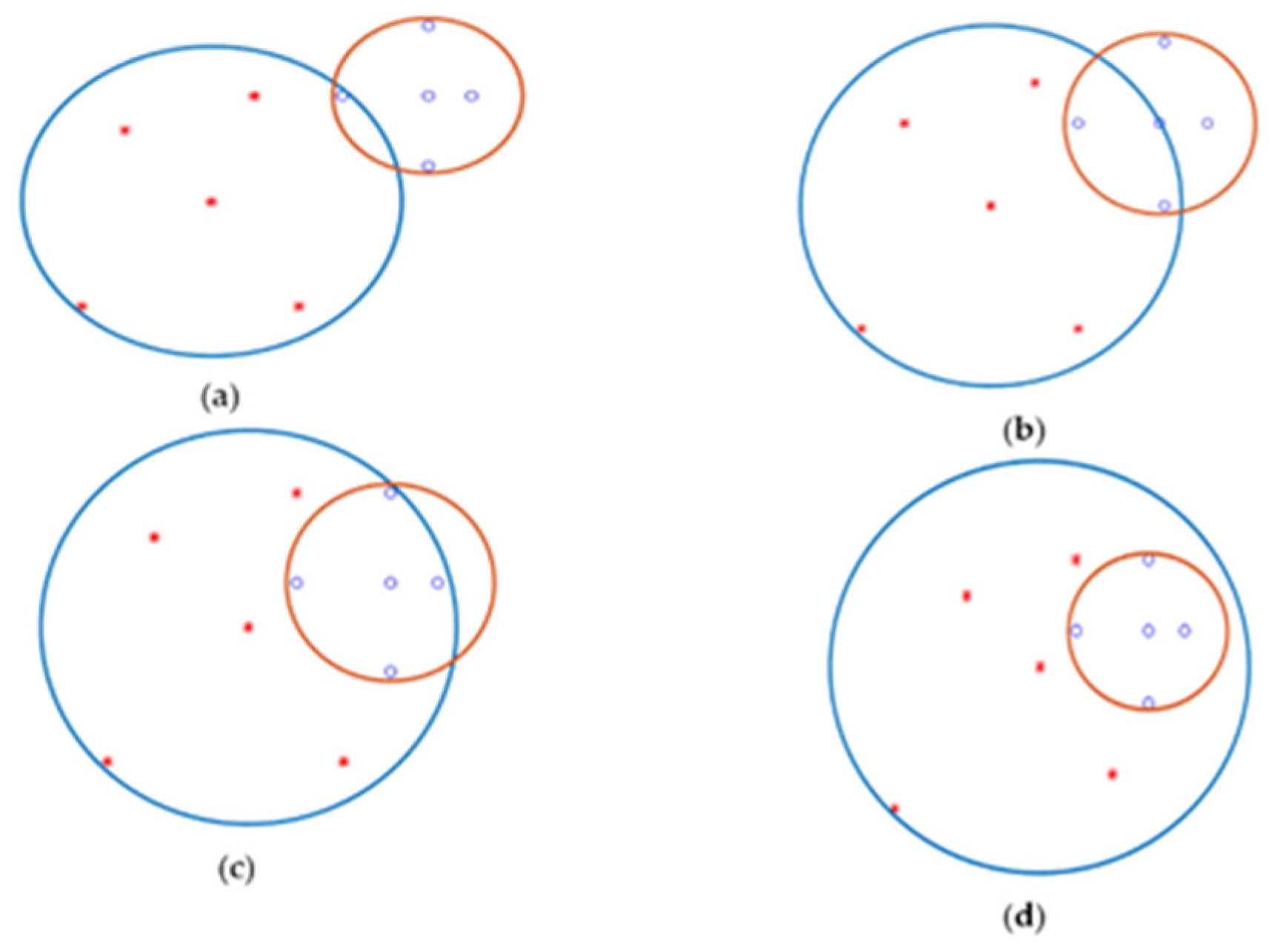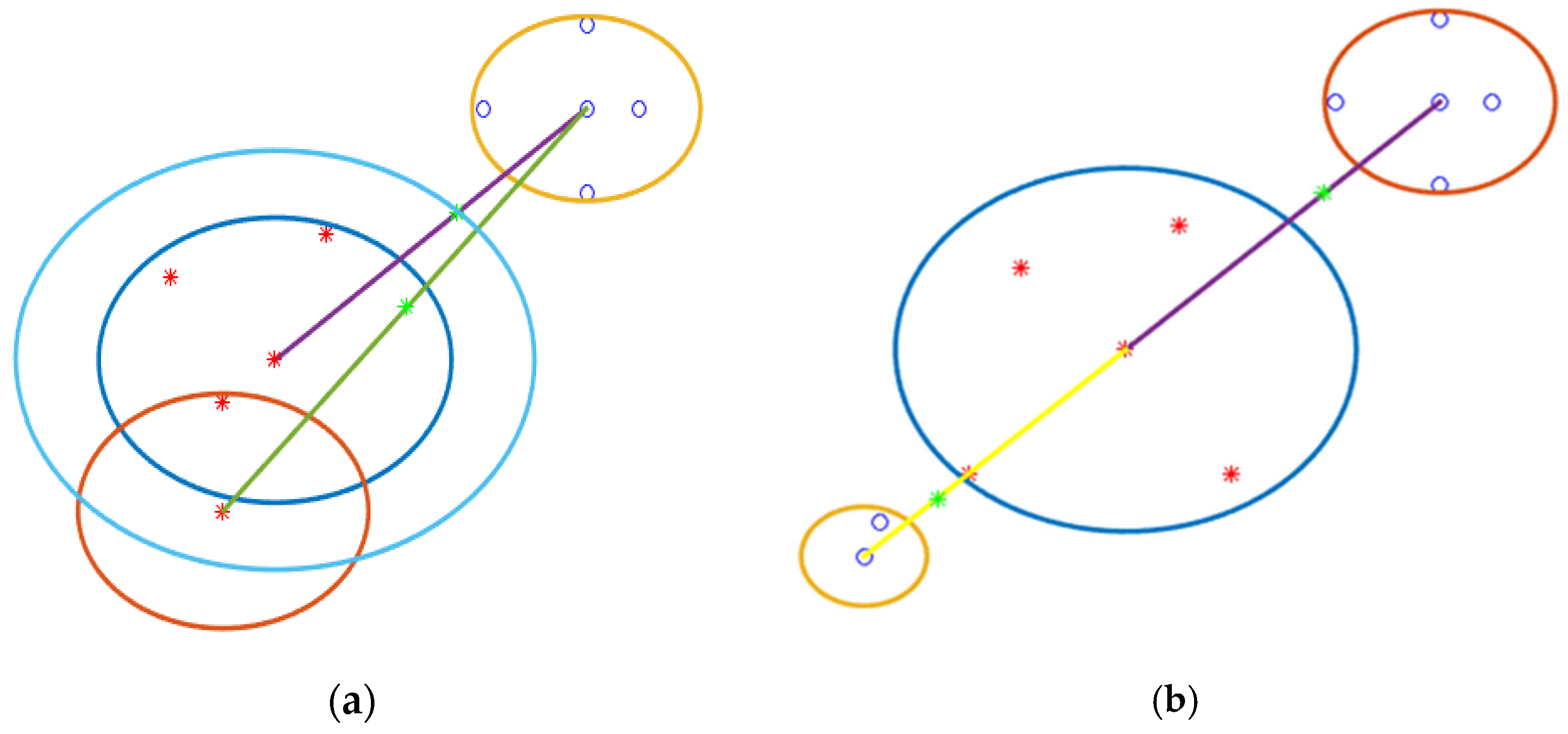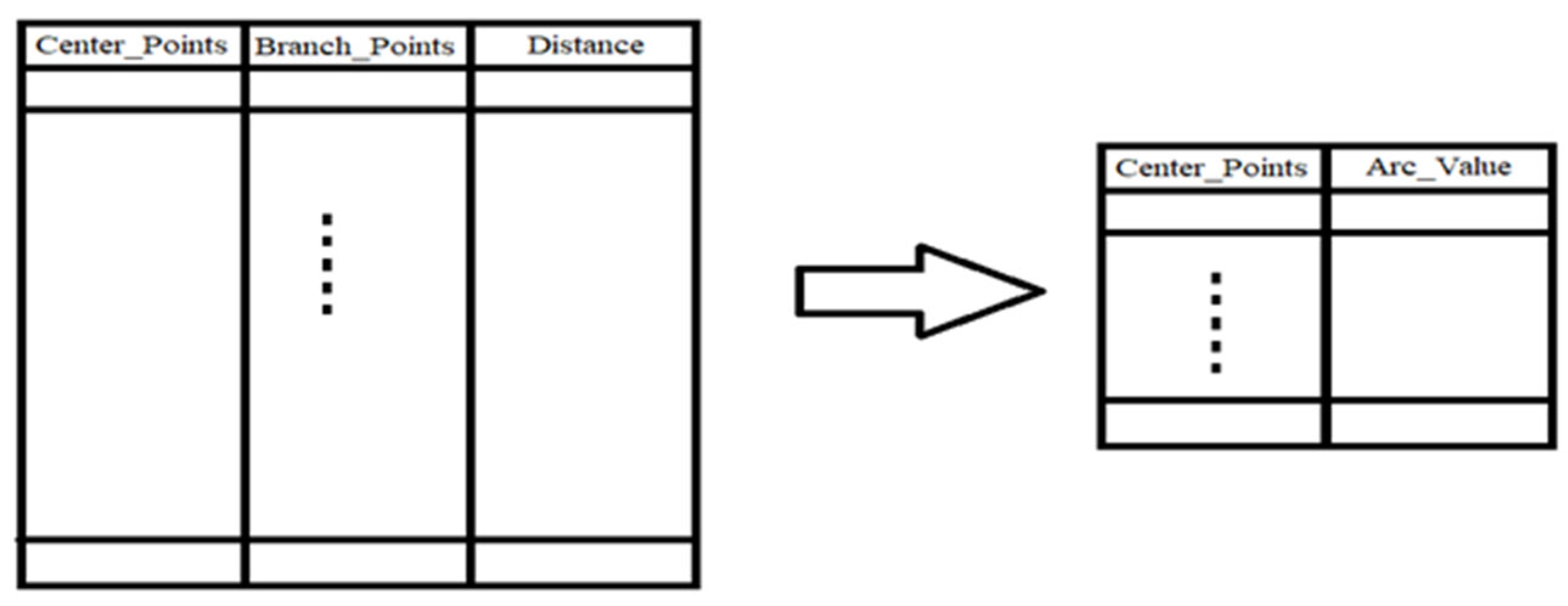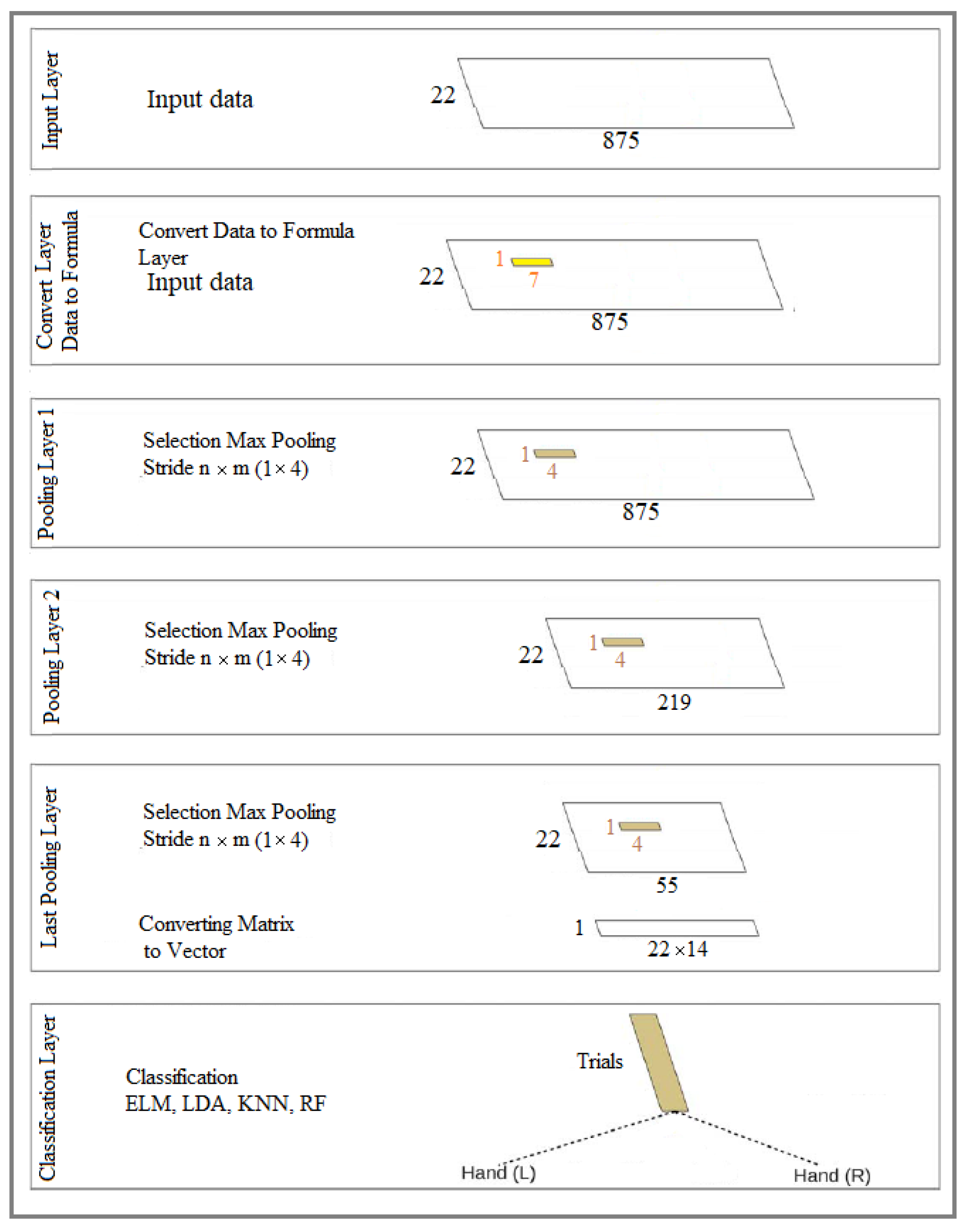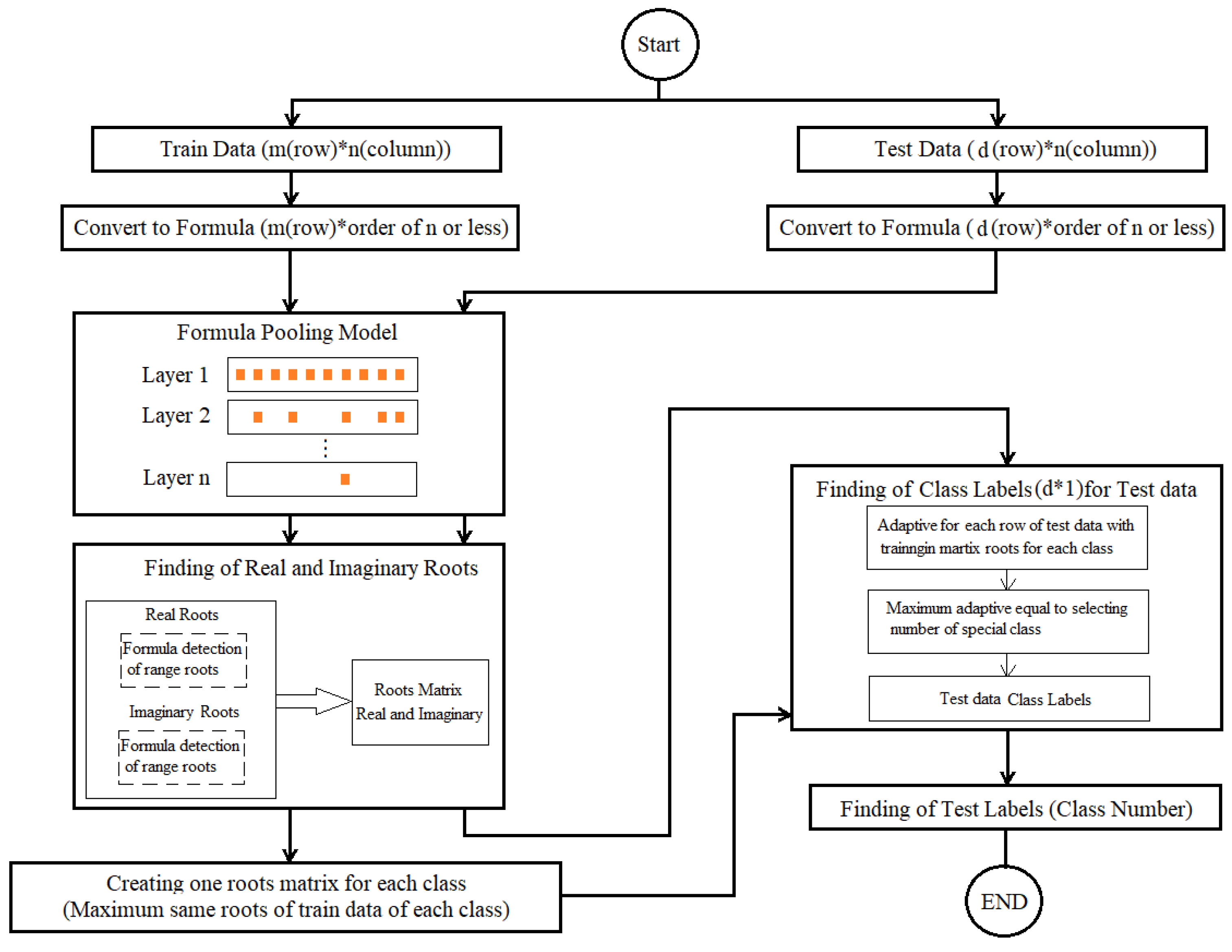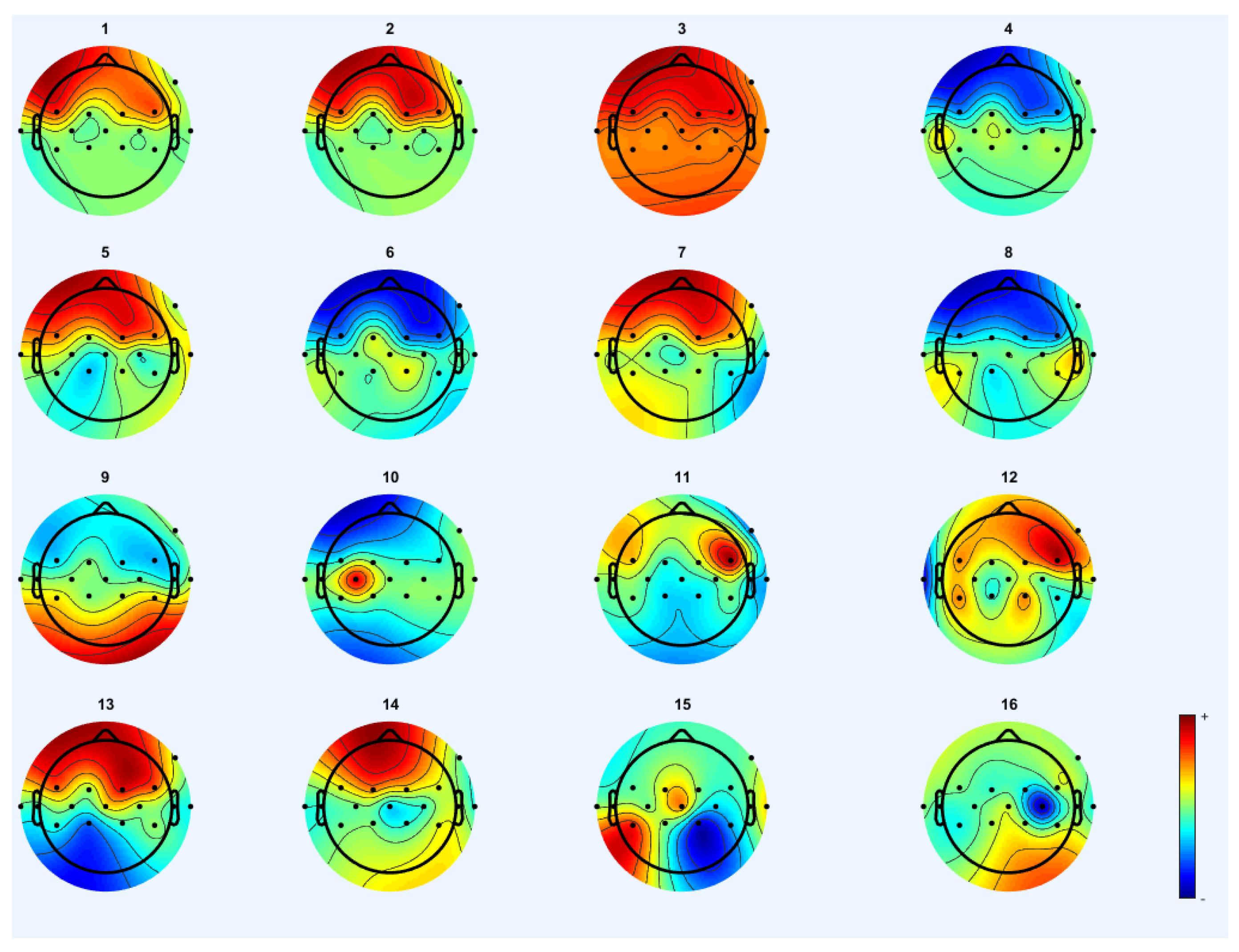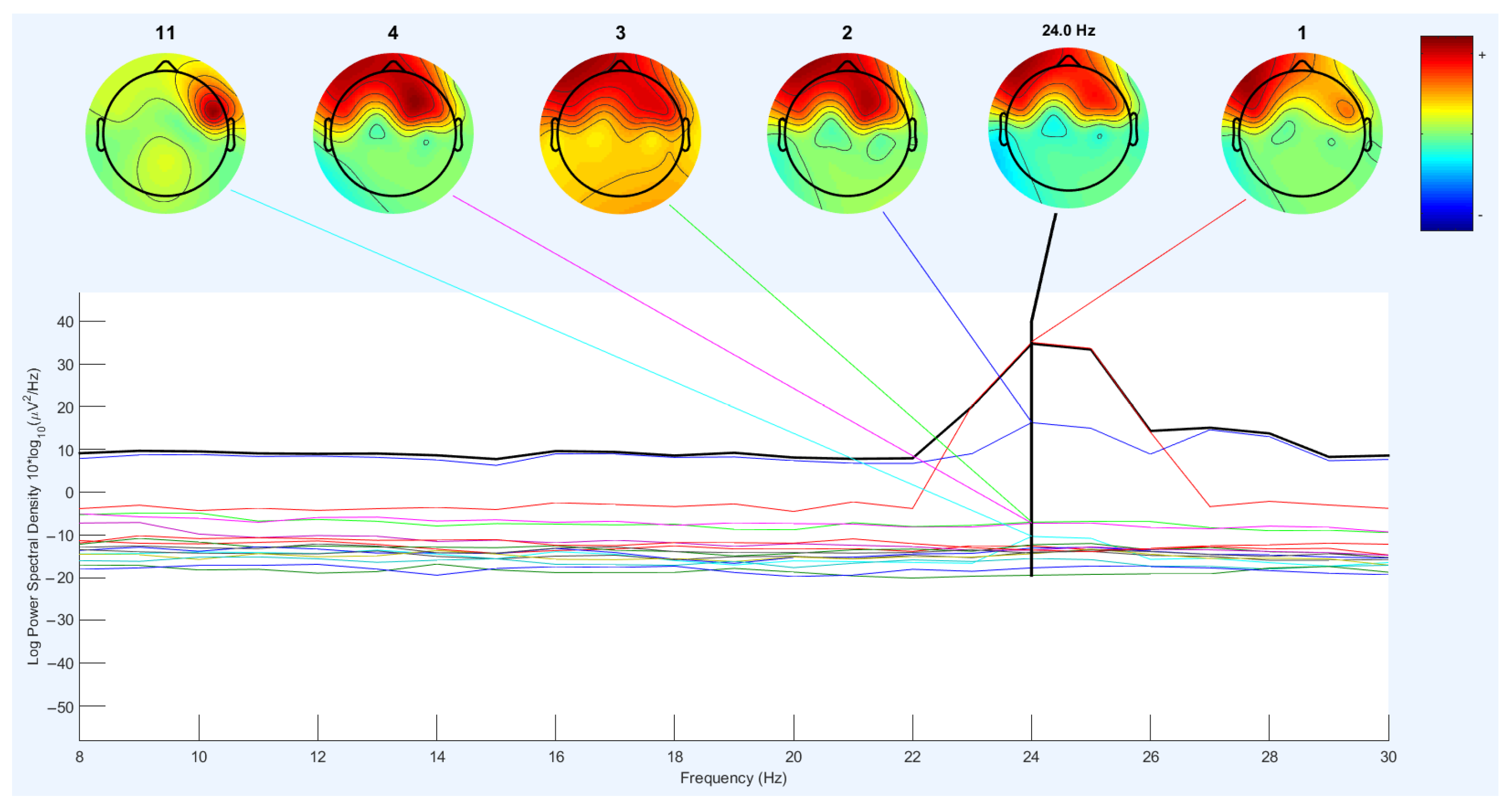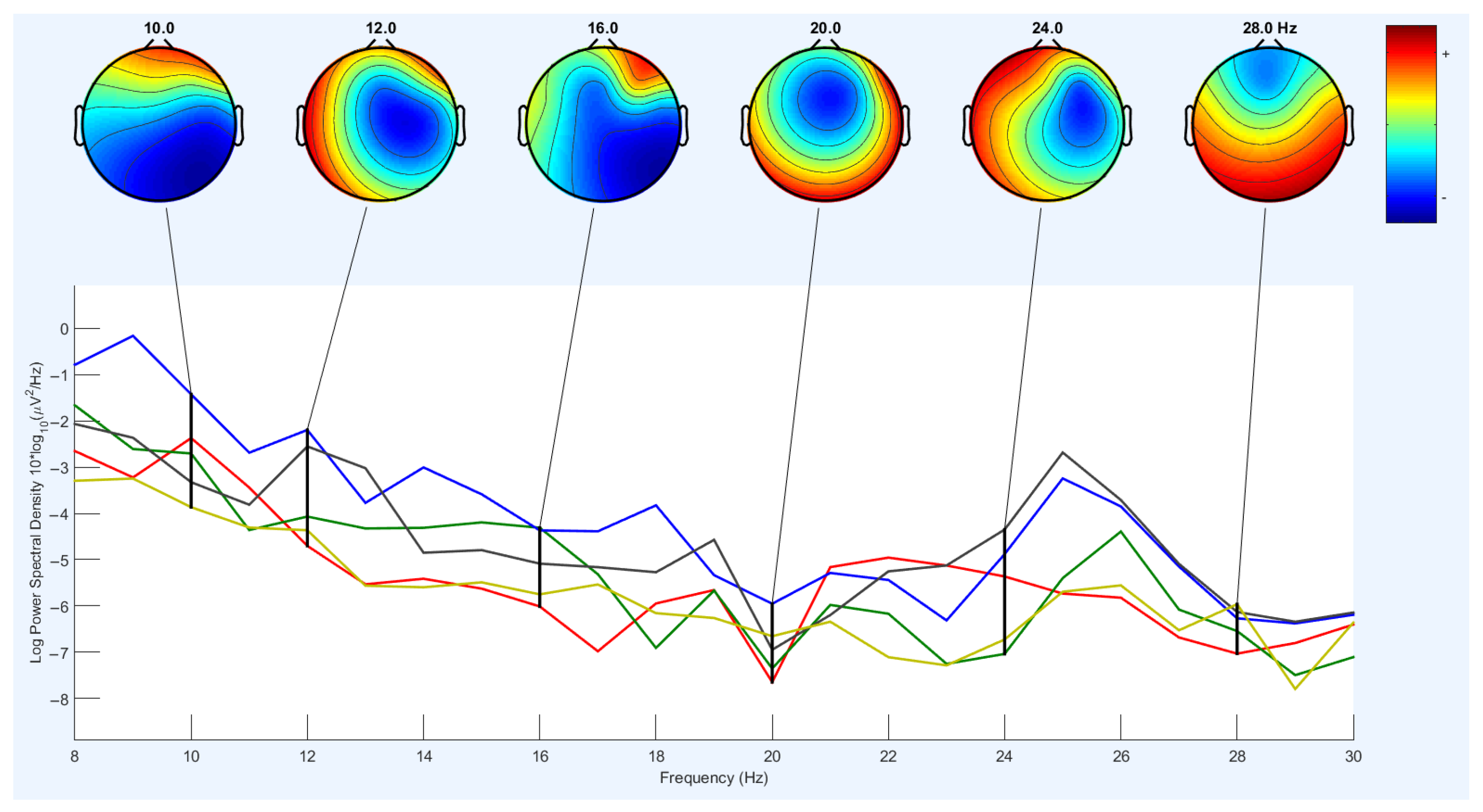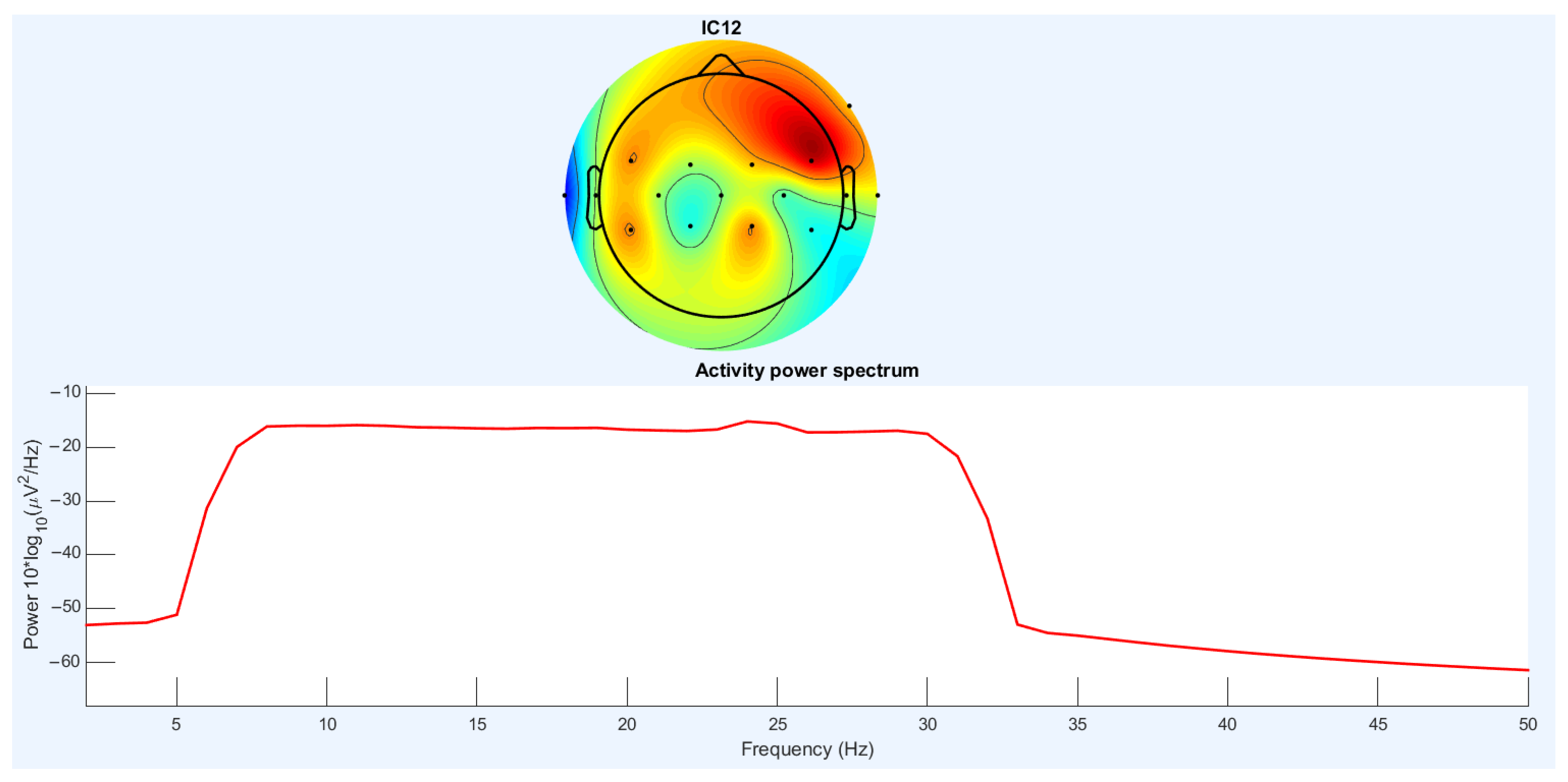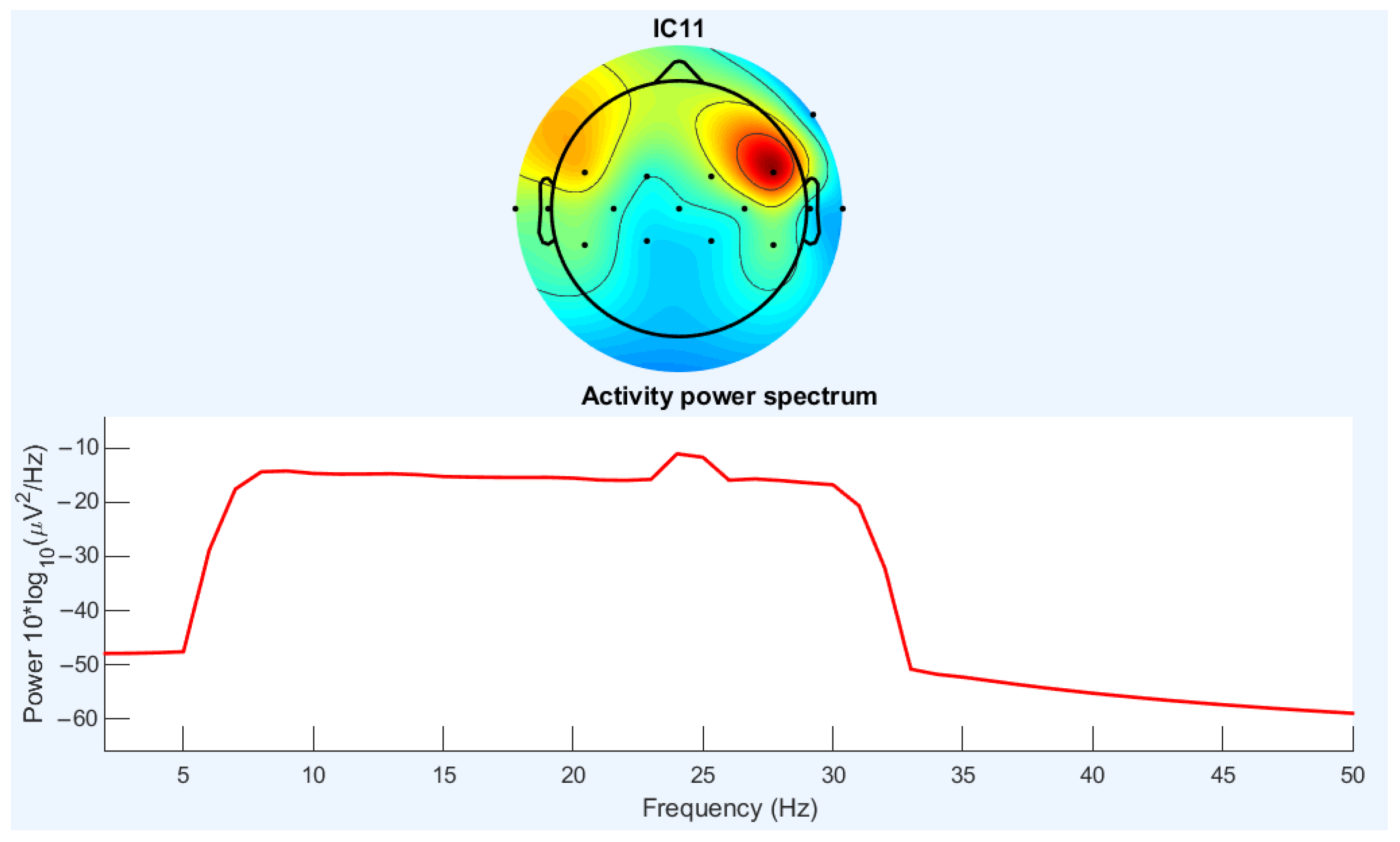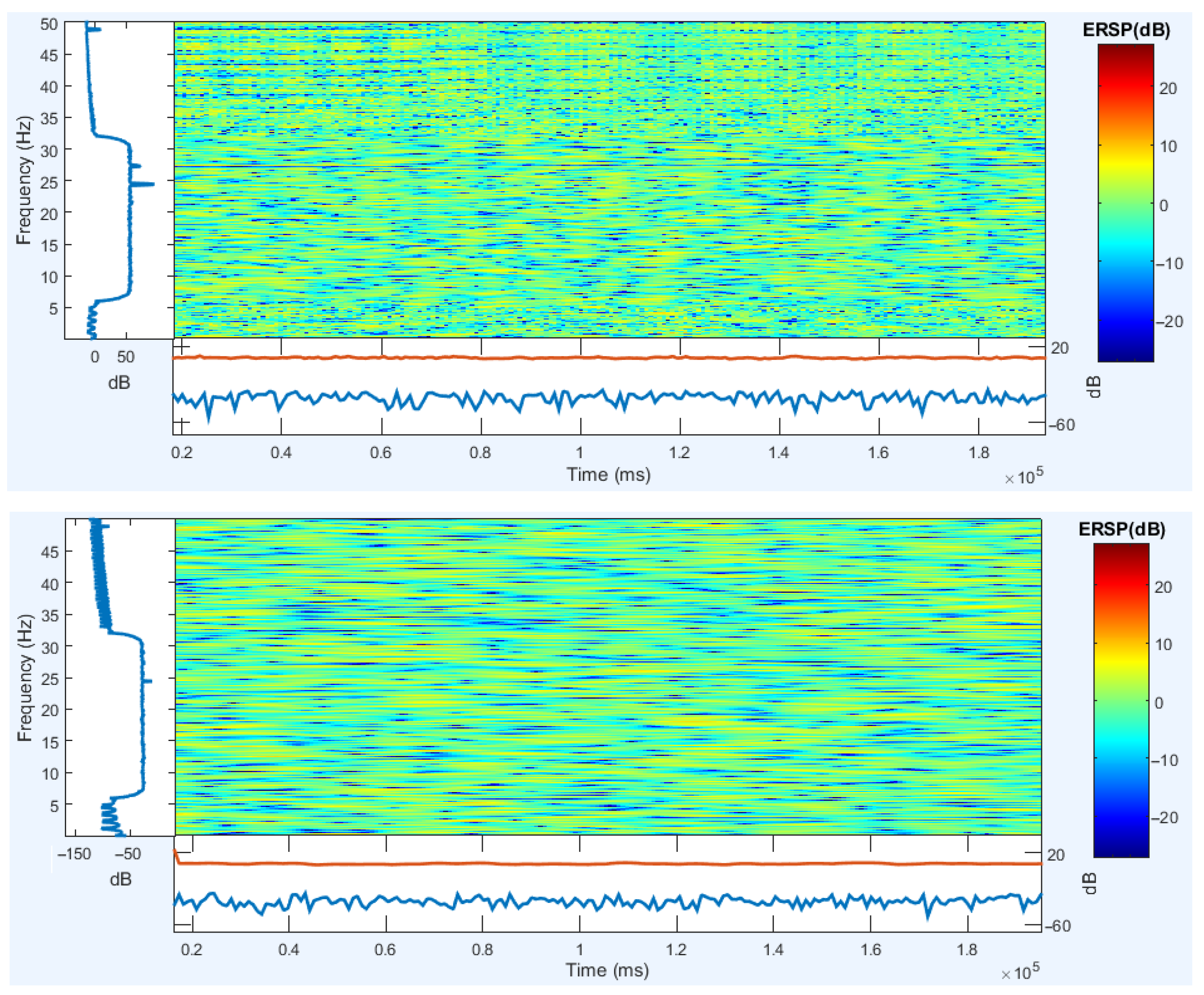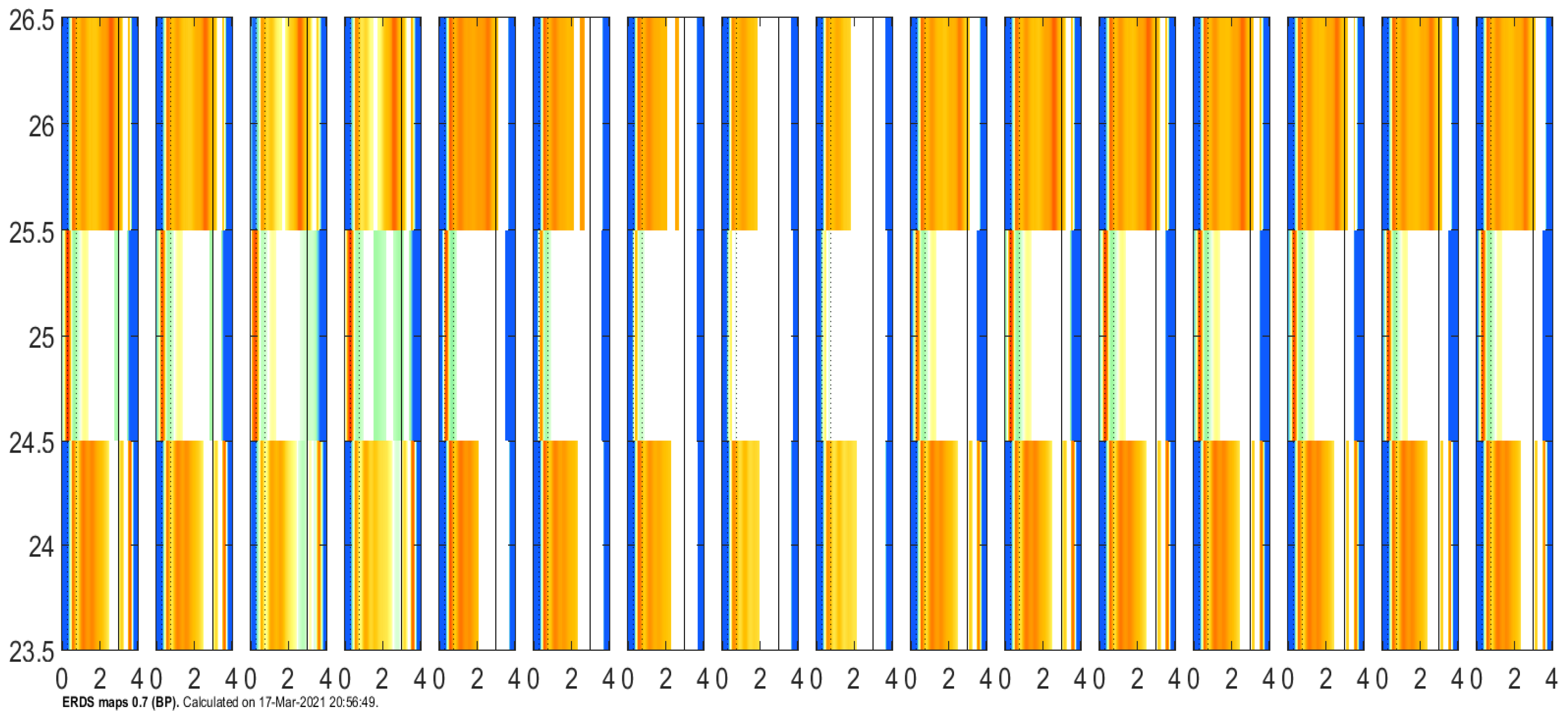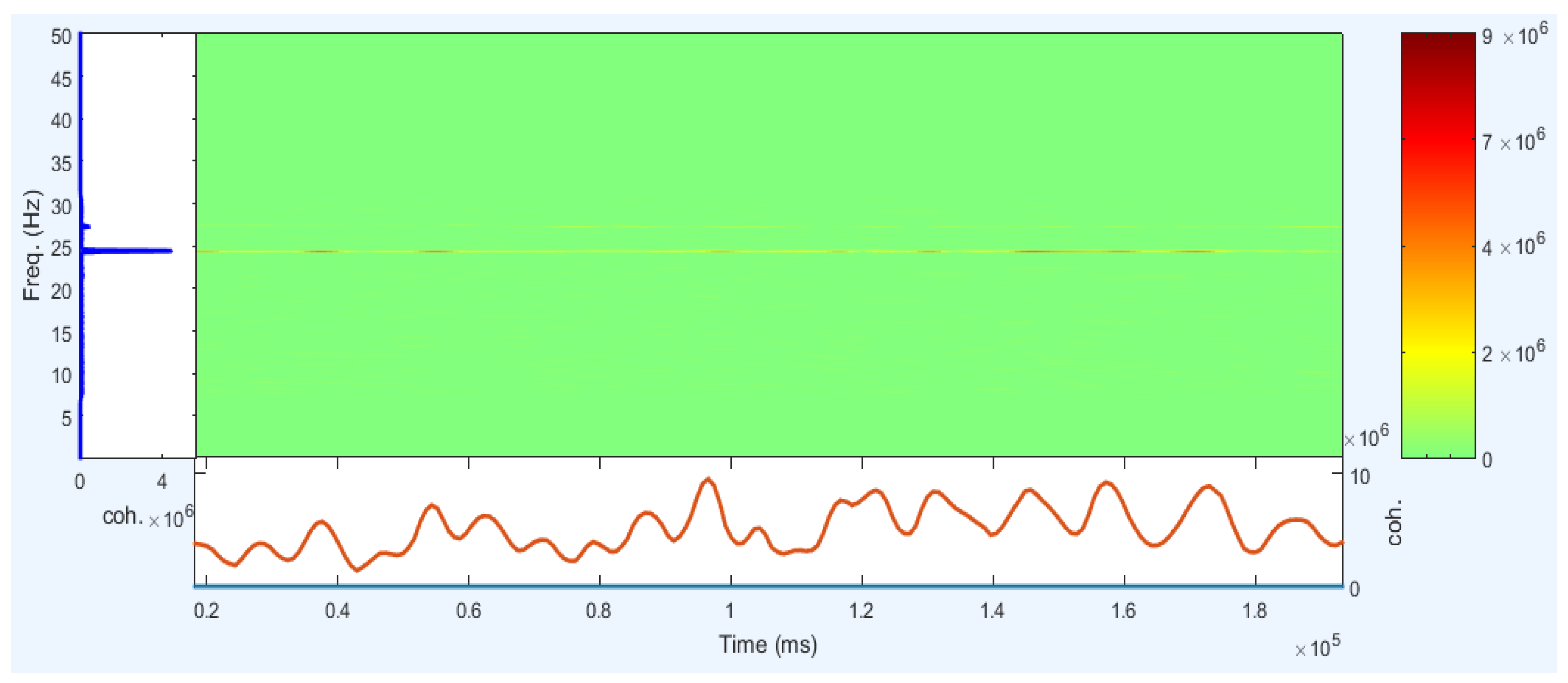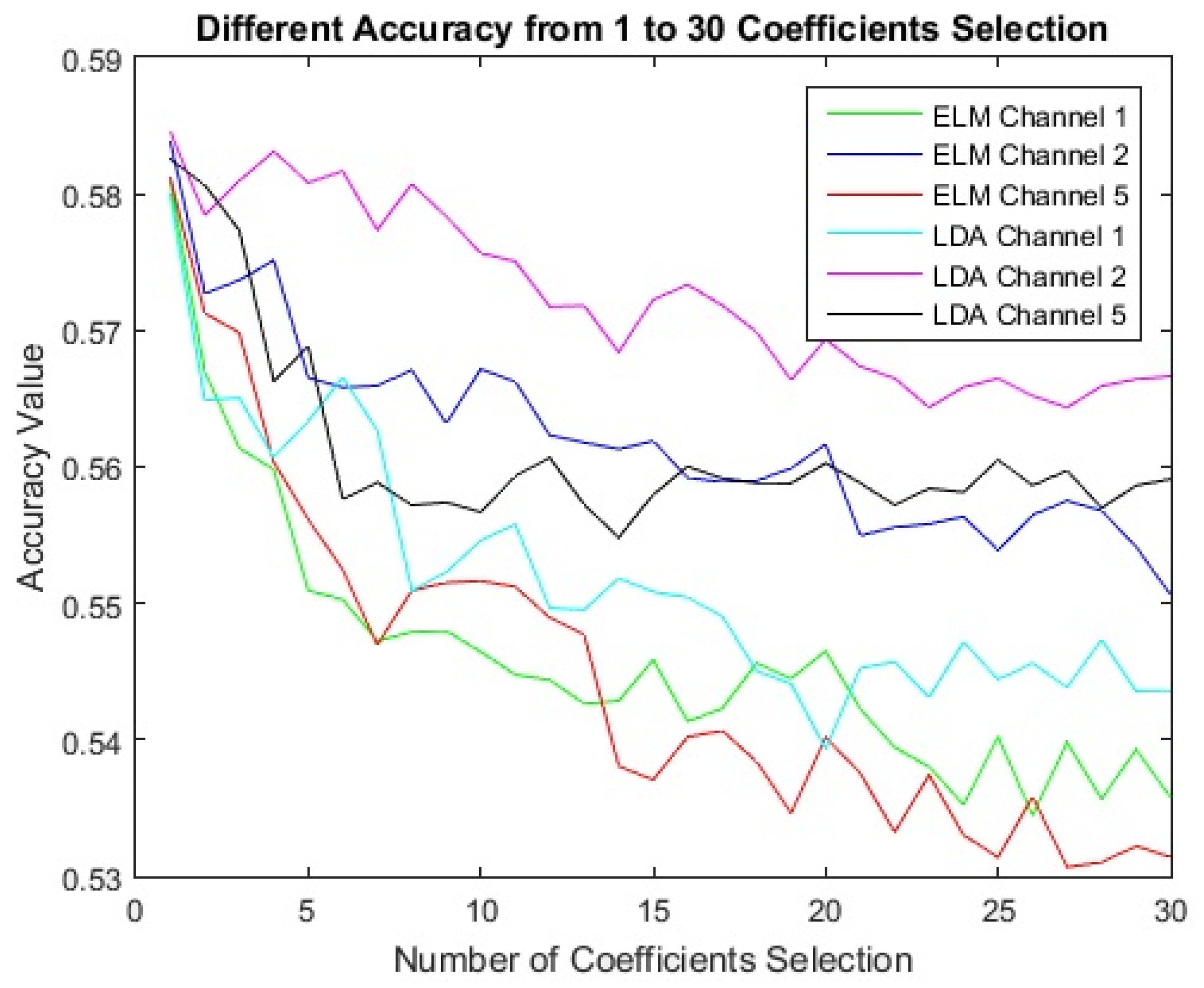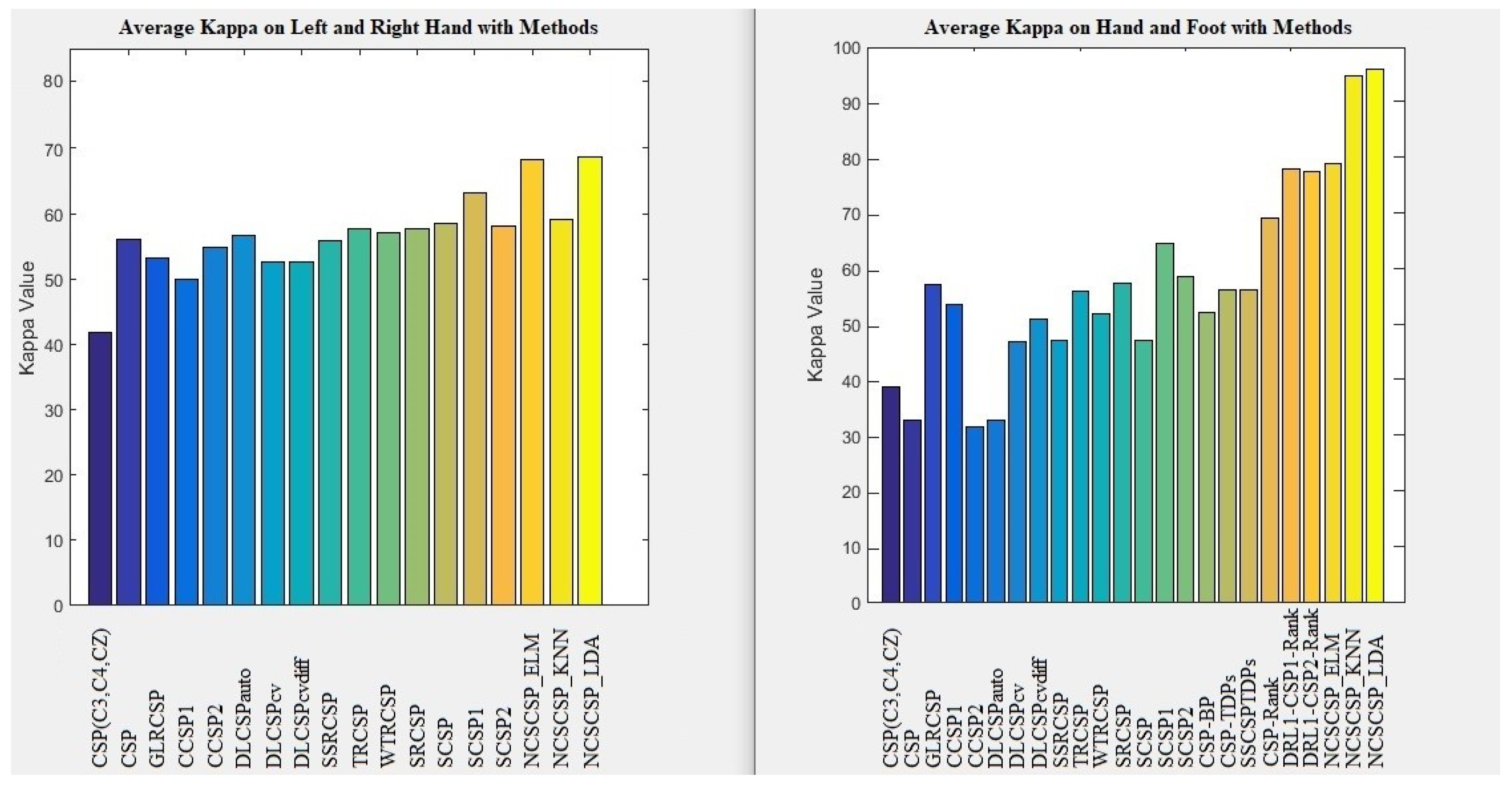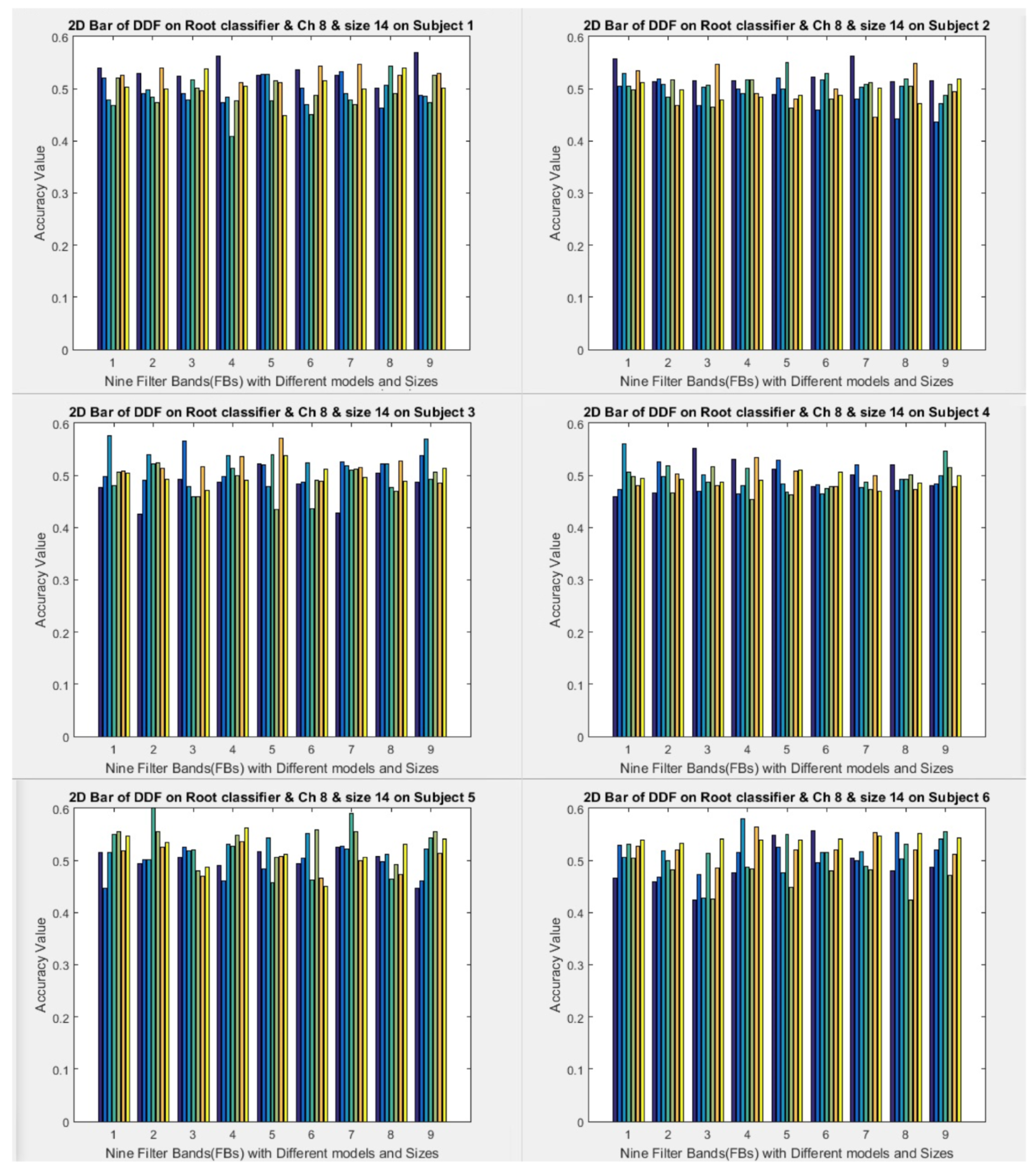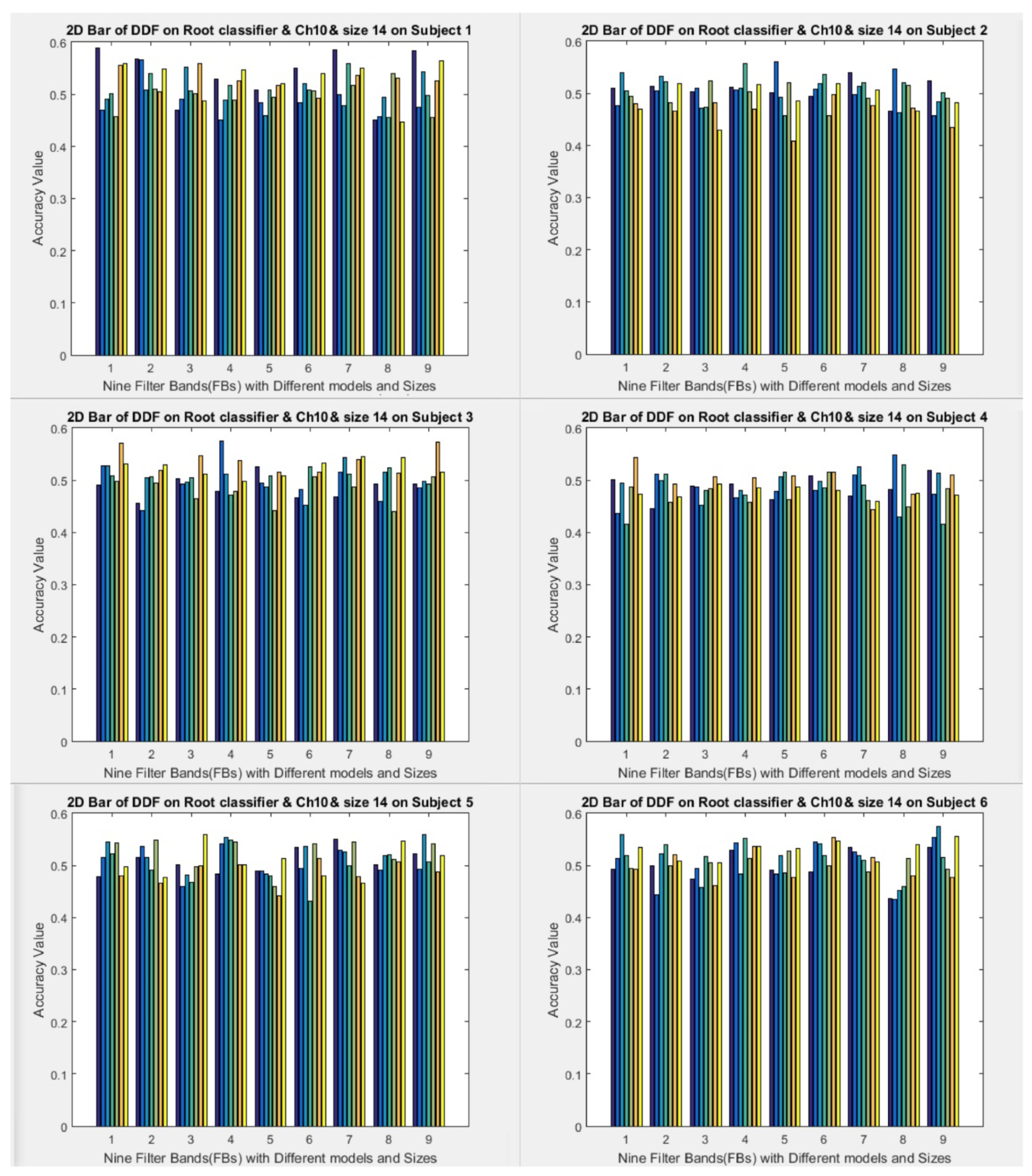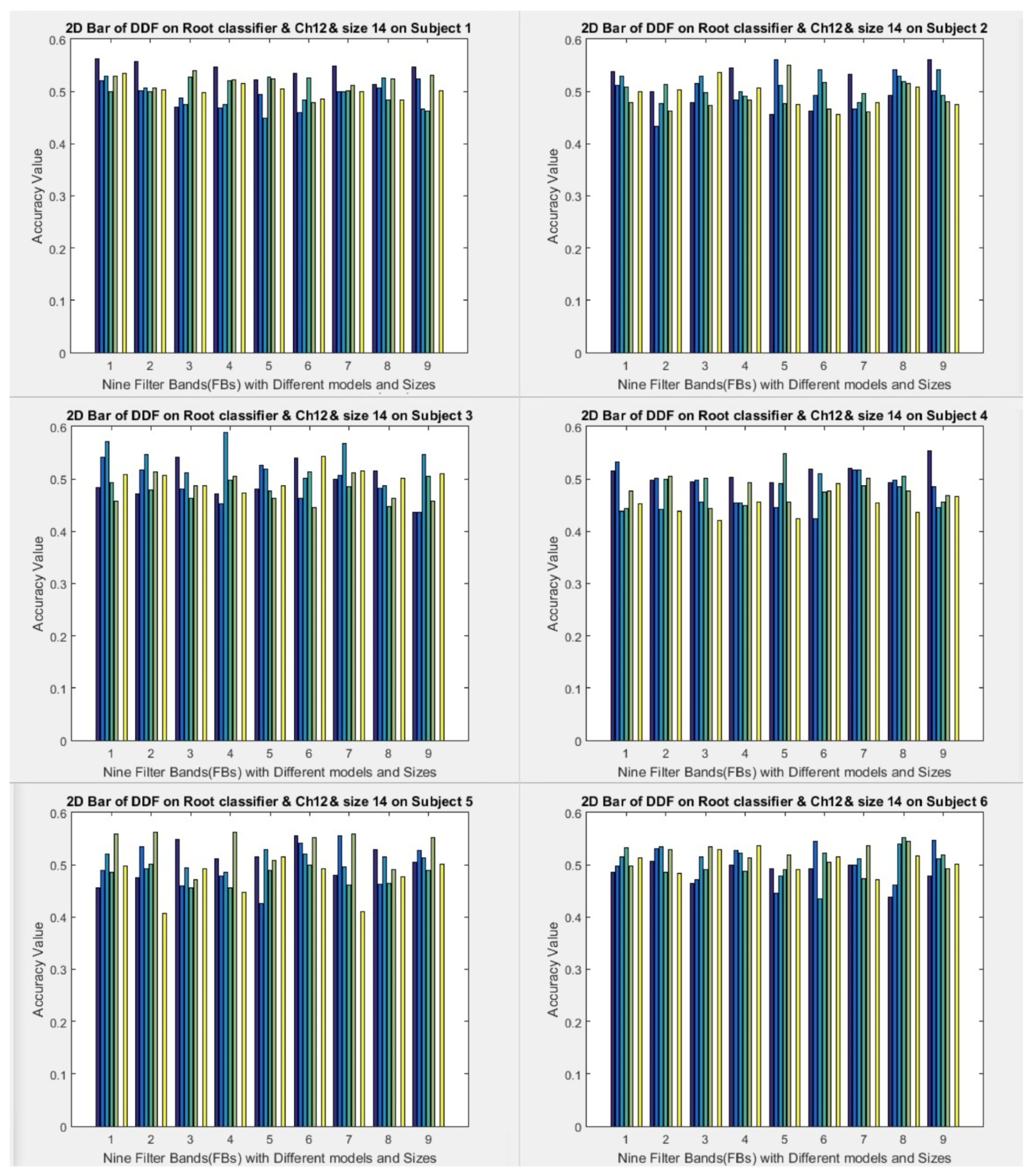Figure 1.
General model of convolution neural network.
Figure 1.
General model of convolution neural network.
Figure 2.
The steps of lip-syncing in 2D for imagining M.
Figure 2.
The steps of lip-syncing in 2D for imagining M.
Figure 3.
The steps of lip-syncing in 3D for imagining M.
Figure 3.
The steps of lip-syncing in 3D for imagining M.
Figure 4.
The geometric lip model for A.
Figure 4.
The geometric lip model for A.
Figure 5.
Feature extraction (FE) from new hybrid signals using common spatial pattern (CSP).
Figure 5.
Feature extraction (FE) from new hybrid signals using common spatial pattern (CSP).
Figure 6.
Feature selection from the entire set of features extracted from new signals like FBCSP.
Figure 6.
Feature selection from the entire set of features extracted from new signals like FBCSP.
Figure 7.
Converting data to polynomial formulas and selecting equation coefficients as features with and without selection for classification.
Figure 7.
Converting data to polynomial formulas and selecting equation coefficients as features with and without selection for classification.
Figure 8.
Checking new hybrid signals by PCA.
Figure 8.
Checking new hybrid signals by PCA.
Figure 9.
An overview of the proposed models running with a signal combination to generate a new signal from the filter bank.
Figure 9.
An overview of the proposed models running with a signal combination to generate a new signal from the filter bank.
Figure 10.
The main structure of connected nodes with distances is described on the left side, and the minimum spanning tree found by the Prim algorithm is shown on the right side.
Figure 10.
The main structure of connected nodes with distances is described on the left side, and the minimum spanning tree found by the Prim algorithm is shown on the right side.
Figure 11.
In the picture, the center of the arcs is connected to two classes (the blue circle is connected to four blue circle points of class one, and the red center point is connected to four red points of class two).
Figure 11.
In the picture, the center of the arcs is connected to two classes (the blue circle is connected to four blue circle points of class one, and the red center point is connected to four red points of class two).
Figure 12.
There are four states in which two center points of two different classes need to break into sub-trees, behaving like a recursive algorithm. (a) A circle from Class A intersects with a circle from Class B, (b) half of a circle from Class A is in a circle from Class B, (c) most of a circle from Class A is in a circle from Class B, (d) a circle of Class A is inside a circle of Class B.
Figure 12.
There are four states in which two center points of two different classes need to break into sub-trees, behaving like a recursive algorithm. (a) A circle from Class A intersects with a circle from Class B, (b) half of a circle from Class A is in a circle from Class B, (c) most of a circle from Class A is in a circle from Class B, (d) a circle of Class A is inside a circle of Class B.
Figure 13.
The steps of boundary detection. (a) There is one boundary, (b) there are two boundaries.
Figure 13.
The steps of boundary detection. (a) There is one boundary, (b) there are two boundaries.
Figure 14.
Creating center point with arc (radius of circle) based on main tree table.
Figure 14.
Creating center point with arc (radius of circle) based on main tree table.
Figure 15.
Overview of formula pooling layers, which are like data pooling layers in normal classifiers.
Figure 15.
Overview of formula pooling layers, which are like data pooling layers in normal classifiers.
Figure 16.
Deep formula detection with root detection classifier structure.
Figure 16.
Deep formula detection with root detection classifier structure.
Figure 17.
Electrode montage corresponding to the international 10–20 system.
Figure 17.
Electrode montage corresponding to the international 10–20 system.
Figure 18.
ICA topography maps on 16 channels between 8 and 30 Hz.
Figure 18.
ICA topography maps on 16 channels between 8 and 30 Hz.
Figure 19.
Maps of power frequency at 25 Hz with different channels between 16 and 36 Hz.
Figure 19.
Maps of power frequency at 25 Hz with different channels between 16 and 36 Hz.
Figure 20.
Topography maps of power frequency at 25 Hz with different channels between 8 and 30 Hz.
Figure 20.
Topography maps of power frequency at 25 Hz with different channels between 8 and 30 Hz.
Figure 21.
Topography maps of power frequency at 25 Hz with different channels with LPSD.
Figure 21.
Topography maps of power frequency at 25 Hz with different channels with LPSD.
Figure 22.
ICA topography map and power of frequency on Channel C3 between 2 Hz and 50 Hz.
Figure 22.
ICA topography map and power of frequency on Channel C3 between 2 Hz and 50 Hz.
Figure 23.
ICA topography map and power of frequency on Channel C4 between 2 Hz and 50 Hz.
Figure 23.
ICA topography map and power of frequency on Channel C4 between 2 Hz and 50 Hz.
Figure 24.
ERSP maps for lip-sync of A and M on Channels C3 and C4.
Figure 24.
ERSP maps for lip-sync of A and M on Channels C3 and C4.
Figure 25.
ERDS Maps 0.7 (BP) related to lipsyncing of M and A between 23 and 27 Hz. Trials: 172; classes: [1, 2]; fs: 256 Hz; time: [0, 0.05, 4] s; ref: [0.25, 0.75] s; f borders: [24, 26] Hz; f bandwidth: 2 Hz; f steps: 1 Hz; Box–Cox significance test (α = 0.06, λ = 1).
Figure 25.
ERDS Maps 0.7 (BP) related to lipsyncing of M and A between 23 and 27 Hz. Trials: 172; classes: [1, 2]; fs: 256 Hz; time: [0, 0.05, 4] s; ref: [0.25, 0.75] s; f borders: [24, 26] Hz; f bandwidth: 2 Hz; f steps: 1 Hz; Box–Cox significance test (α = 0.06, λ = 1).
Figure 26.
Maps of Cohen coefficients.
Figure 26.
Maps of Cohen coefficients.
Figure 27.
Accuracy of selected coefficients with ELM and LDA for Channels 1, 2, and 5.
Figure 27.
Accuracy of selected coefficients with ELM and LDA for Channels 1, 2, and 5.
Figure 28.
(Left) Evaluation of the best kappa values for different methods with a new combination of signals from the right and left hands. (Right) Evaluation of the best kappa values of different methods with a new combination of signals from the hand and foot.
Figure 28.
(Left) Evaluation of the best kappa values for different methods with a new combination of signals from the right and left hands. (Right) Evaluation of the best kappa values of different methods with a new combination of signals from the hand and foot.
Figure 29.
Deep detection with root classifier on Channel 8 with size 14 for Subjects 1 to 6 (accuracy).
Figure 29.
Deep detection with root classifier on Channel 8 with size 14 for Subjects 1 to 6 (accuracy).
Figure 30.
Deep detection with root classifier on Channel 10 with size 14 for Subjects 1 to 6 (accuracy).
Figure 30.
Deep detection with root classifier on Channel 10 with size 14 for Subjects 1 to 6 (accuracy).
Figure 31.
Deep detection with root classifier on Channel 12 with size 14 for Subjects 1 to 6 (accuracy).
Figure 31.
Deep detection with root classifier on Channel 12 with size 14 for Subjects 1 to 6 (accuracy).
Table 1.
Classification of all states for 3D lips for A and M.
Table 1.
Classification of all states for 3D lips for A and M.
| Subject | CSP(m) | SVM | LDA | ELM | KNN | TREE |
|---|
| S1 | 4 | 0.664 | 0.547 | 0.634 | 0.687 | 0.652 |
| S1 | 5 | 0.676 | 0.582 | 0.601 | 0.681 | 0.658 |
| S2 | 4 | 0.624 | 0.561 | 0.677 | 0.619 | 0.576 |
| S2 | 5 | 0.615 | 0.569 | 0.698 | 0.644 | 0.559 |
| S3 | 4 | 0.615 | 0.571 | 0.657 | 0.639 | 0.546 |
| S3 | 5 | 0.632 | 0.581 | 0.668 | 0.664 | 0.552 |
Table 2.
Average kappa values of three classifiers using hybrid signals from the left and right hands with 10 features.
Table 2.
Average kappa values of three classifiers using hybrid signals from the left and right hands with 10 features.
| Classifier Type | FB 1 1 and 5 | FB2 and 5 | FB4 and 5 | FB3 and 6 | FB5 and 6 | FB4 and 8 | FB6 and 8 | FB5 and 9 | FB8 and 9 |
|---|
| ELM | 63.31 | 62.55 | 63.51 | 63.19 | 68.34 | 63.34 | 66.92 | 67.79 | 62.21 |
| KNN | 51.99 | 50.96 | 51.81 | 50.97 | 59.04 | 47.95 | 55.36 | 56.02 | 49.57 |
| LDA | 64.37 | 64.31 | 64.64 | 61.52 | 68.70 | 61.06 | 64.24 | 68.22 | 63.34 |
Table 3.
Kappa values with LDA classifier of hybrid signals from left and right hands with 10 features.
Table 3.
Kappa values with LDA classifier of hybrid signals from left and right hands with 10 features.
| Subject | FB 1 1 and 5 | FB2 and 5 | FB4 and 5 | FB3 and 6 | FB5 and 6 | FB4 and 8 | FB6 and 8 | FB5 and 9 | FB8 and 9 |
|---|
| S1 | 64.08 | 61.65 | 66.44 | 68.87 | 77.09 | 56.54 | 77.75 | 68.98 | 68.74 |
| S2 | 48.44 | 41.99 | 47.14 | 41.97 | 49.42 | 40.92 | 43.46 | 48.18 | 50.85 |
| S3 | 91.37 | 93.52 | 88.95 | 88.81 | 97.02 | 75.63 | 94.42 | 93.15 | 70.50 |
| S4 | 45.61 | 50.27 | 51.07 | 50.30 | 62.96 | 60.39 | 54.11 | 64.97 | 58.76 |
| S5 | 39.20 | 52.50 | 46.84 | 36.95 | 44.93 | 47.92 | 37.44 | 42.54 | 50.63 |
| S6 | 45.36 | 44.89 | 59.67 | 47.49 | 64.44 | 48.36 | 56.97 | 65.12 | 51.49 |
| S7 | 90.60 | 80.43 | 59.87 | 66.65 | 67.48 | 63.13 | 58.43 | 71.20 | 68.86 |
| S8 | 92.01 | 90.69 | 95.21 | 92.61 | 92.02 | 91.65 | 92.23 | 94.91 | 88.81 |
| S9 | 62.64 | 62.84 | 66.55 | 60.02 | 62.97 | 65.02 | 63.41 | 64.92 | 61.38 |
| Average | 64.37 | 64.31 | 64.64 | 61.52 | 68.70 | 61.06 | 64.24 | 68.22 | 63.34 |
| p-value | 0.015 | 0.007 | 0.004 | 0.009 | 0.002 | 0.014 | 0.002 | 0.003 | 0.016 |
Table 4.
Average sensitivity values of three classifiers using hybrid signals from the left and right hands with 10 features.
Table 4.
Average sensitivity values of three classifiers using hybrid signals from the left and right hands with 10 features.
| Classifier Type | FB 1 1 and 5 | FB2 and 5 | FB4 and 5 | FB3 and 6 | FB5 and 6 | FB4 and 8 | FB6 and 8 | FB5 and 9 | FB8 and 9 |
|---|
| ELM_Class_Left | 81.65 | 81.24 | 82.32 | 81.89 | 84.66 | 81.98 | 83.78 | 84.31 | 81.48 |
| ELM_Class_Rightt | 82.85 | 82.55 | 82.61 | 82.56 | 85.04 | 82.60 | 84.26 | 84.67 | 82.07 |
| KNN_Class_Left | 76.48 | 76.00 | 75.95 | 75.60 | 80.17 | 74.18 | 77.61 | 78.19 | 75.18 |
| KNN_Class_Rightt | 76.50 | 75.99 | 77.02 | 76.24 | 80.00 | 74.79 | 78.72 | 78.91 | 75.61 |
| LDA_Class_Left | 81.95 | 82.23 | 82.08 | 81.04 | 84.09 | 81.35 | 82.27 | 84.15 | 82.90 |
| LDA_Class_Rightt | 83.68 | 83.42 | 83.86 | 81.86 | 85.97 | 81.06 | 83.25 | 85.44 | 81.72 |
Table 5.
Average kappa values of three classifiers using hybrid signals from hand and foot with 10 features (m = 5).
Table 5.
Average kappa values of three classifiers using hybrid signals from hand and foot with 10 features (m = 5).
| Classifier Type | FB 1 1 and 2 | FB4 and 5 | FB4 and 6 | FB4 and 7 | FB4 and 8 | FB1 and 9 | FB2 and 9 | FB3 and 9 | FB4 and 9 |
|---|
| ELM | 72.94 | 73.04 | 73.41 | 75.79 | 75.81 | 78.36 | 77.86 | 78.82 | 77.93 |
| KNN | 91.49 | 89.63 | 90.61 | 94.14 | 94.10 | 93.97 | 94.11 | 94.60 | 94.60 |
| LDA | 92.47 | 93.99 | 93.97 | 94.50 | 95.30 | 95.21 | 95.77 | 95.90 | 95.79 |
Table 6.
Kappa values with LDA classifier of hybrid signals from hand and foot with 10 features (m = 5).
Table 6.
Kappa values with LDA classifier of hybrid signals from hand and foot with 10 features (m = 5).
| Subject | FB 1 1 and 2 | FB4 and 5 | FB4 and 6 | FB4 and 7 | FB4 and 8 | FB1 and 9 | FB2 and 9 | FB3 and 9 | FB4 and 9 |
|---|
| S1 | 94.71 | 96.57 | 94.64 | 95.93 | 95.79 | 95.43 | 95.5 | 96.42 | 95.21 |
| S2 | 92.57 | 94.64 | 93.50 | 94.64 | 93.64 | 93.71 | 94.79 | 94.04 | 95.50 |
| S3 | 86.64 | 87.71 | 91.36 | 92.00 | 94.86 | 94.79 | 95.00 | 94.78 | 94.57 |
| S4 | 92.79 | 92.71 | 94.79 | 95.71 | 97.86 | 97.86 | 97.86 | 97.86 | 97.86 |
| S5 | 95.64 | 98.29 | 95.57 | 94.21 | 94.36 | 94.29 | 95.71 | 96.38 | 95.79 |
| Average | 92.47 | 93.99 | 93.97 | 94.50 | 95.30 | 95.21 | 95.77 | 95.90 | 95.79 |
| p-value | 0.0060 | 0.0053 | 0.0061 | 0.0065 | 0.0067 | 0.0066 | 0.0060 | 0.0061 | 0.0058 |
Table 7.
Average sensitivity values of three classifiers using hybrid signals from hand and foot with 10 features.
Table 7.
Average sensitivity values of three classifiers using hybrid signals from hand and foot with 10 features.
| Classifier Type | FB 1 1 and 2 | FB4 and 5 | FB4 and 6 | FB4 and 7 | FB4 and 8 | FB1 and 9 | FB2 and 9 | FB3 and 9 | FB4 and 9 |
|---|
| KNN_Class_Left | 88.83 | 90.18 | 91.11 | 91.39 | 92.18 | 90.16 | 92.03 | 92.72 | 92.30 |
| KNN_Class_Rightt | 89.93 | 90.28 | 90.88 | 91.37 | 91.88 | 91.23 | 92.64 | 92.32 | 91.95 |
| LDA_Class_Left | 93.48 | 94.02 | 93.86 | 93.81 | 93.99 | 94.31 | 94.15 | 94.33 | 94.09 |
| LDA_Class_Rightt | 91.90 | 93.23 | 93.02 | 93.36 | 93.60 | 93.76 | 93.99 | 94.15 | 94.46 |
Table 8.
Average accuracies of two classifiers based on feature selection (FBCSP) with different numbers of features.
Table 8.
Average accuracies of two classifiers based on feature selection (FBCSP) with different numbers of features.
| Classifier/FS Numbers | 5 | 10 | 15 | 20 | 25 | 30 | 35 | 40 |
|---|
| LDA_Accuracy | 84.05 | 83.75 | 83.94 | 83.96 | 84.07 | 83.96 | 83.91 | 84.01 |
| KNN_Accuracy | 86.51 | 86.47 | 86.52 | 86.52 | 86.58 | 86.46 | 86.55 | 86.45 |
| LDA_Kappa | 68.11 | 67.49 | 67.89 | 67.91 | 68.13 | 67.92 | 67.83 | 68.01 |
| KNN_Kappa | 73.01 | 72.94 | 73.04 | 73.03 | 73.15 | 72.92 | 73.09 | 72.9 |
Table 9.
Kappa values of KNN classifier based on feature selection (FBCSP) with different numbers of features.
Table 9.
Kappa values of KNN classifier based on feature selection (FBCSP) with different numbers of features.
| Subject/FS Numbers | 5 | 10 | 15 | 20 | 25 | 30 | 35 | 40 |
|---|
| 1 | 87.12 | 86.58 | 87.3 | 87.35 | 87.2 | 86.59 | 87.12 | 87.31 |
| 2 | 55.94 | 55.73 | 55.8 | 55.92 | 55.72 | 56.52 | 56.46 | 55.67 |
| 3 | 92.71 | 92.63 | 92.97 | 92.64 | 92.68 | 92.35 | 92.99 | 92.49 |
| 4 | 55.81 | 55.91 | 55.58 | 55.66 | 56.1 | 55.92 | 55.58 | 56.47 |
| 5 | 59.81 | 59.65 | 60.11 | 60.09 | 60.1 | 59.39 | 60.27 | 59.13 |
| 6 | 59.59 | 59.34 | 59.42 | 59.59 | 60.26 | 59.5 | 59.39 | 59.05 |
| 7 | 89.5 | 89.97 | 90.22 | 89.73 | 89.6 | 89.98 | 89.65 | 89.35 |
| 8 | 93.34 | 93.33 | 93 | 93.41 | 93.55 | 93.27 | 93.4 | 93.64 |
| 9 | 63.31 | 63.31 | 62.95 | 62.89 | 63.16 | 62.78 | 62.98 | 62.97 |
| Avg | 73.01 | 72.94 | 73.04 | 73.03 | 73.15 | 72.92 | 73.09 | 72.9 |
| Std | 16.01 | 16.06 | 16.16 | 16.09 | 15.97 | 15.96 | 16.05 | 16.12 |
| p-value | 0.0039 | 0.004 | 0.0041 | 0.0041 | 0.0039 | 0.0042 | 0.004 | 0.0039 |
Table 10.
Average accuracy on Channel 5 with FBs and 30 selected features with Lagrangian formula.
Table 10.
Average accuracy on Channel 5 with FBs and 30 selected features with Lagrangian formula.
| Classifier–Channel | FB 1 4 and 7 | FB1 and 8 | FB4 and 8 | FB7 and 8 | FB1 and 9 | FB2 and 9 | FB5 and 9 | FB7 and 9 | FB8 and 9 |
|---|
| ELM_Channel 5 | 56.41 | 57.12 | 56.80 | 57.18 | 58.11 | 57.39 | 57.56 | 57.29 | 58.16 |
| LDA_Channel 5 | 57.41 | 57.35 | 57.54 | 58.06 | 57.98 | 57.78 | 58.02 | 58.25 | 58.03 |
Table 11.
Classification with Lagrangian formula using selection of 1 feature or 30 features for different channels.
Table 11.
Classification with Lagrangian formula using selection of 1 feature or 30 features for different channels.
| Classifier–FS 1–Channel | FB 2 1 | FB2 | FB3 | FB4 | FB5 | FB6 | FB7 | FB8 | FB9 |
|---|
| ELM_1FS_channel 1 | 56.8 | 58.09 | 56.7 | 56.19 | 57.71 | 56.78 | 57.23 | 56.76 | 57.71 |
| ELM_30FS_channel 1 | 52.17 | 53.58 | 52.76 | 52.89 | 54.21 | 52.16 | 52.72 | 51.84 | 53.06 |
| ELM_1FS_channel 2 | 54.81 | 54.52 | 56.95 | 58.7 | 57.28 | 57.27 | 55.57 | 59.71 | 59.74 |
| ELM_30FS_channel 2 | 51.24 | 53.5 | 50.44 | 52.67 | 51.38 | 52.87 | 52.33 | 51.65 | 55.33 |
| ELM_1FS_channel 5 | 46.08 | 56.26 | 55.22 | 58.69 | 57.26 | 56.58 | 53.47 | 58.33 | 55.59 |
| ELM_30FS_channel 5 | 47.02 | 49.71 | 49.96 | 54.32 | 50.91 | 49.59 | 51.08 | 50.23 | 49.85 |
| LDA_1FS_channel 1 | 56.9 | 57.84 | 57.45 | 56.92 | 57.56 | 57.5 | 56.48 | 57.99 | 56.53 |
| LDA_30FS_channel 1 | 53.36 | 55.09 | 55.91 | 54.66 | 56.05 | 56.23 | 55.18 | 54.35 | 54.79 |
| LDA_1FS_channel 2 | 58.13 | 57.19 | 57.38 | 57.89 | 57.56 | 57.66 | 56.93 | 58.45 | 58.37 |
| LDA_30FS_channel 2 | 56.75 | 55.73 | 56.32 | 55.94 | 56.98 | 55.24 | 54.67 | 56.66 | 57.11 |
| LDA_1FS_channel 5 | 56.87 | 58.03 | 58.25 | 57.56 | 58.02 | 57.53 | 55.84 | 57.78 | 57.98 |
| LDA_30FS_channel 5 | 52.86 | 55.82 | 55.91 | 53.85 | 55.35 | 56 | 55.62 | 54.95 | 53.79 |
Table 12.
ELM with PCA on Channels 8 and 12 on the left- and right-hand datasets composed of filter banks.
Table 12.
ELM with PCA on Channels 8 and 12 on the left- and right-hand datasets composed of filter banks.
| Classifier–Channel–Signal Type | FB1 | FB2 | FB3 | FB4 | FB5 | FB6 | FB7 | FB8 | FB9 |
|---|
| ELM_ Channel 8_Normal_FB | 50.51 | 50.12 | 50.4 | 49.96 | 50.6 | 50.28 | 50.39 | 50.08 | 50.08 |
| ELM_ Channel 12_Normal_FB | 50.23 | 50.21 | 49.48 | 50.06 | 49.91 | 50.33 | 50.35 | 50.38 | 50.2 |
Table 13.
ELM with PCA on Channels 8 and 12 on the left- and right-hand datasets composed of new hybrid signals.
Table 13.
ELM with PCA on Channels 8 and 12 on the left- and right-hand datasets composed of new hybrid signals.
| Classifier–Channel–Signal Type | FB 1 2 and 3 | FB3 and 4 | FB1 and 5 | FB3 and 7 | FB4 and 8 | FB7 and 8 | FB3 and 9 | FB5 and 9 | FB8 and 9 |
|---|
| ELM_Channel 8_New Signal_of_FBs | 60.48 | 58.17 | 67.87 | 59.74 | 63.08 | 56.70 | 53.26 | 63.93 | 54.98 |
| ELM_ Channel 12_New Signal_of_FBs | 60.56 | 57.44 | 68.09 | 59.41 | 62.86 | 56.62 | 52.73 | 63.64 | 54.25 |
Table 14.
Evaluation of the best kappa results of different methods with the best accuracy of the average of the combined signals of the filter banks on the right- and left-hand sides.
Table 14.
Evaluation of the best kappa results of different methods with the best accuracy of the average of the combined signals of the filter banks on the right- and left-hand sides.
| Methods | S1 | S2 | S3 | S4 | S5 | S6 | S7 | S8 | S9 | Avg | Std | p-Value |
|---|
| CSP (C3,C4,CZ) | 51.38 | 6.94 | 86.1 | 36.1 | 6.94 | 22.22 | 15.26 | 73.6 | 77.76 | 41.81 | 29.64 | - |
| CSP | 77.78 | 2.78 | 93.06 | 40.28 | 9.72 | 43.06 | 62.5 | 87.5 | 87.5 | 56.02 | 32.08 | 0.0125 |
| GLRCSP | 72.22 | 16.66 | 87.5 | 34.72 | 11.12 | 30.56 | 62.5 | 87.5 | 76.38 | 53.24 | 28.48 | 0.0275 |
| CCSP1 | 72.22 | 20.84 | 87.5 | 13.88 | −1.38 | 30.56 | 62.5 | 87.5 | 76.38 | 50 | 32.2 | 0.1230 |
| CCSP2 | 77.78 | 6.94 | 94.44 | 40.28 | 8.34 | 36.12 | 58.34 | 90.28 | 80.56 | 54.79 | 31.7 | 0.0125 |
| DLCSPauto | 77.78 | 2.78 | 93.06 | 40.28 | 13.88 | 43.06 | 63.88 | 87.5 | 87.5 | 56.64 | 31.47 | 0.0105 |
| DLCSPcv | 77.78 | 1.38 | 93.06 | 40.28 | 11.12 | 25 | 62.5 | 87.5 | 73.62 | 52.47 | 32.12 | 0.0460 |
| DLCSPcvdiff | 77.78 | 1.38 | 93.06 | 40.28 | 11.12 | 25 | 62.5 | 87.5 | 73.62 | 52.47 | 32.12 | 0.0460 |
| SSRCSP | 77.78 | 6.94 | 94.44 | 40.28 | 12.5 | 37.5 | 58.34 | 94.44 | 80.56 | 55.86 | 31.49 | 0.0080 |
| TRCSP | 77.78 | 8.34 | 93.06 | 41.66 | 25 | 34.72 | 62.5 | 91.74 | 83.34 | 57.57 | 29.41 | 0.0050 |
| WTRCSP | 77.78 | 9.72 | 93.06 | 40.28 | 31.94 | 23.62 | 62.5 | 91.66 | 81.94 | 56.94 | 29.52 | 0.0090 |
| SRCSP | 77.78 | 26.38 | 93.06 | 33.34 | 26.38 | 27.78 | 56.94 | 91.66 | 84.72 | 57.56 | 27.86 | 0.0035 |
| SCSP | 81.94 | 12.5 | 93.04 | 45.82 | 27.76 | 27.76 | 59.72 | 94.44 | 83.32 | 58.48 | 29.47 | 0.0030 |
| SCSP1 | 83.32 | 34.72 | 95.82 | 44.44 | 30.54 | 33.34 | 69.44 | 94.44 | 83.32 | 63.26 | 25.84 | 0.0015 |
| SCSP2 | 83.32 | 20.82 | 94.28 | 41.66 | 26.38 | 22.22 | 56.94 | 90.26 | 87.5 | 58.15 | 29.44 | 0.0030 |
| NCSCSP 1_ELM | 75.95 | 49.61 | 94.93 | 60.76 | 48.46 | 61.41 | 66.2 | 88.29 | 69.47 | 68.34 | 14.98 | 0.0260 |
| NCSCSP 1_KNN | 70.68 | 29.89 | 96.65 | 41.21 | 38.63 | 47.18 | 53.53 | 87.96 | 65.63 | 59.04 | 21.56 | 0.0045 |
| NCSCSP 1_LDA | 77.09 | 49.42 | 97.02 | 62.96 | 44.93 | 64.44 | 67.48 | 92.02 | 62.97 | 68.70 | 16.46 | 0.0020 |
Table 15.
Evaluation of the best kappa values of the results of different methods with the best average accuracies using the combined signals of the filter banks for the hand and foot.
Table 15.
Evaluation of the best kappa values of the results of different methods with the best average accuracies using the combined signals of the filter banks for the hand and foot.
| Methods | S1 | S2 | S3 | S4 | S5 | Avg | Std | p-Value |
|---|
| CSP (C3,C4,CZ) | 8.56 | 60 | 10 | 40 | 74.28 | 38.57 | 26.28 | - |
| CSP | 32.14 | 92.86 | 0 | 43.76 | 0 | 32.56 | 34.28 | 0.3850 |
| GLRCSP | 44.64 | 92.86 | 33.68 | 35.72 | 78.58 | 57.1 | 24.09 | 0.0400 |
| CCSP1 | 33.92 | 92.86 | 26.54 | 43.76 | 69.84 | 53.38 | 24.58 | 0.0480 |
| CCSP2 | 30.36 | 92.86 | 0 | 43.76 | 0 | 31.4 | 34.3 | 0.3635 |
| DLCSPauto | 33.92 | 92.86 | 0 | 42.86 | 0 | 32.7 | 34.22 | 0.3875 |
| DLCSPcv | 28.58 | 92.86 | 4.08 | 43.76 | 65.08 | 46.86 | 30.4 | 0.1780 |
| DLCSPcvdiff | 39.28 | 96.42 | 10.2 | 43.76 | 65.08 | 50.94 | 28.69 | 0.1195 |
| SSRCSP | 41.08 | 92.86 | 7.14 | 43.76 | 50.78 | 47.12 | 27.39 | 0.2370 |
| TRCSP | 42.86 | 92.86 | 26.54 | 43.76 | 73.8 | 55.96 | 23.94 | 0.0365 |
| WTRCSP | 39.28 | 96.42 | 9.18 | 43.76 | 70.64 | 51.86 | 29.61 | 0.0945 |
| SRCSP | 44.64 | 92.86 | 20.4 | 55.36 | 73.02 | 57.26 | 24.65 | 0.0280 |
| SCSP | 48.56 | 88.56 | 0 | 54.28 | 45.7 | 47.12 | 28.26 | 0.2680 |
| SCSP1 | 61.42 | 94.28 | 14.28 | 70 | 82.84 | 64.56 | 27.51 | 0.0215 |
| SCSP2 | 42.84 | 91.42 | 14.28 | 55.7 | 88.56 | 58.56 | 28.97 | 0.0120 |
| CSP-BP | 0 | 88 | 36 | 88 | 50 | 52 | 33.33 | 0.2145 |
| CSP-TDPs | 0 | 88 | 38 | 88 | 68 | 56 | 33.62 | 0.1140 |
| SSCSPTDPs | 34 | 76 | 22 | 62 | 84 | 56 | 23.91 | 0.0025 |
| CSP-Rank | 67.2 | 95 | 15 | 82.2 | 85.8 | 69.04 | 31.83 | 0.0185 |
| DRL1-CSP1-Rank | 72.8 | 95.8 | 46.4 | 85 | 89.2 | 77.84 | 19.47 | 0.0040 |
| DRL1-CSP2-Rank | 70.8 | 95.8 | 47.2 | 85 | 87.8 | 77.32 | 19.11 | 0.0040 |
| NCSCSP_ELM | 80.6 | 76.5 | 74.82 | 80.28 | 81.88 | 78.82 | 2.68 | 0.0170 |
| NCSCSP_KNN | 93.86 | 94.82 | 88.04 | 99.04 | 97.24 | 94.60 | 3.75 | 0.0050 |
| NCSCSP_LDA | 96.42 | 94.04 | 94.78 | 97.86 | 96.38 | 95.90 | 1.35 | 0.0060 |
Table 16.
Evaluation of the best accuracy of the results of different methods with the best average accuracy of the combined signals of the filter banks for the hand and foot.
Table 16.
Evaluation of the best accuracy of the results of different methods with the best average accuracy of the combined signals of the filter banks for the hand and foot.
| Methods | S1 | S2 | S3 | S4 | S5 | Avg | Std | p-Value |
|---|
| CSP (C3,C4,CZ) | 54.28 | 80.00 | 55.00 | 70.00 | 87.14 | 69.28 | 14.69 | - |
| CSP-Ref | 90.36 | 98.36 | 76.64 | 98.64 | 94.50 | 91.70 | 8.11 | 0.0049 |
| CSP | 81.93 | 98.64 | 74.00 | 97.07 | 92.86 | 88.90 | 9.46 | 0.0034 |
| CSSP | 87.07 | 95.71 | 74.86 | 98.07 | 94.86 | 90.11 | 8.47 | 0.0039 |
| CSSSP1 | 90.79 | 99.11 | 75.79 | 99.57 | 94.21 | 91.89 | 8.68 | 0.0040 |
| CSSSP2 | 91.00 | 98.93 | 76.14 | 99.07 | 93.86 | 91.80 | 8.41 | 0.0041 |
| SPEC-CSP | 83.93 | 99.21 | 72.50 | 98.93 | 92.36 | 89.30 | 10.11 | 0.0036 |
| FBCSP1 | 90.64 | 98.93 | 66.29 | 98.50 | 96.07 | 90.09 | 12.26 | 0.0035 |
| FBCSP2 | 89.29 | 99.07 | 69.79 | 98.71 | 95.64 | 90.50 | 10.93 | 0.0034 |
| FBCSP3 | 88.21 | 98.93 | 72.93 | 99.00 | 95.43 | 90.90 | 9.81 | 0.0034 |
| DFBCSP1 | 92.29 | 99.29 | 78.07 | 99.29 | 95.07 | 92.80 | 7.83 | 0.0040 |
| DFBCSP2 | 91.00 | 99.14 | 76.43 | 99.57 | 95.64 | 92.36 | 8.54 | 0.0037 |
| NCSCSP_ELM | 90.30 | 88.24 | 87.41 | 90.14 | 90.94 | 89.40 | 1.34 | 0.0085 |
| NCSCSP_KNN | 96.92 | 97.40 | 94.01 | 99.51 | 98.62 | 97.29 | 1.88 | 0.0048 |
| NCSCSP_LDA | 98.21 | 97.01 | 97.39 | 98.92 | 98.19 | 97.94 | 0.67 | 0.0054 |
Table 17.
Evaluation of the best kappa values of the results of different methods with the best average accuracy of the combined signals of the filter banks for the right and left hands.
Table 17.
Evaluation of the best kappa values of the results of different methods with the best average accuracy of the combined signals of the filter banks for the right and left hands.
| Methods | S1 | S2 | S3 | S4 | S5 | S6 | S7 | S8 | S9 | Avg | Std |
|---|
| CSP_Channels | 81.94 | 12.5 | 93.04 | 45.82 | 27.76 | 27.76 | 59.72 | 94.44 | 83.32 | 58.48 | 29.47 |
| CSP 8.55 Channels | 83.32 | 20.82 | 94.28 | 41.66 | 26.38 | 22.22 | 56.94 | 90.26 | 87.5 | 58.15 | 29.44 |
| CSS 13.22 Channels | 83.32 | 34.72 | 95.82 | 44.44 | 30.54 | 33.34 | 69.44 | 94.44 | 83.32 | 63.26 | 25.84 |
| oFBCSP | 72 | 38.9 | 82.2 | 38.1 | 56.3 | 25.5 | 80 | 78.5 | 74.7 | 60.7 | 20.33 |
| sFBCSP | 72.1 | 39.5 | 81.6 | 38.4 | 59.2 | 28.7 | 83 | 78.6 | 76 | 61.9 | 19.94 |
| aFBCSP | 74.7 | 41.6 | 82.4 | 40 | 60.8 | 30.9 | 84.9 | 78.7 | 77.2 | 63.5 | 19.61 |
| NCSCSP 1_ELM | 75.95 | 49.61 | 94.93 | 60.76 | 48.46 | 61.41 | 66.2 | 88.29 | 69.47 | 68.34 | 14.98 |
| NCSCSP 1_KNN | 70.68 | 29.89 | 96.65 | 41.21 | 38.63 | 47.18 | 53.53 | 87.96 | 65.63 | 59.04 | 21.56 |
| NCSCSP 1_LDA | 77.09 | 49.42 | 97.02 | 62.96 | 44.93 | 64.44 | 67.48 | 92.02 | 62.97 | 68.70 | 16.46 |
Table 18.
Linear classifiers on Dataset SI.
Table 18.
Linear classifiers on Dataset SI.
| Subject | Channel | SVM | LDA | BGL M1 | BGL M2 | BGL M3 |
|---|
| Avg | 1 | 0.501 | 0.487 | 0.532 | 0.535 | 0.523 |
| 2 | 0.513 | 0.512 | 0.517 | 0.538 | 0.527 |
| 3 | 0.553 | 0.652 | 0.604 | 0.596 | 0.554 |
| 4 | 0.558 | 0.593 | 0.601 | 0.61 | 0.601 |
Table 19.
Nonlinear classifiers on Dataset SI.
Table 19.
Nonlinear classifiers on Dataset SI.
| Subject | Channel | KNN | LDA | SVM | BG N-Linear |
|---|
| Avg | 1 | 0.579 | 0.487 | 0.501 | 0.553 |
| 2 | 0.595 | 0.527 | 0.513 | 0.554 |
| 3 | 0.657 | 0.513 | 0.553 | 0.56 |
| 4 | 0.623 | 0.513 | 0.558 | 0.561 |
Table 20.
Linear classifiers on Dataset IVa.
Table 20.
Linear classifiers on Dataset IVa.
| Subject | Channel | SVM | LDA | BG Linear M1 |
|---|
| Avg | 1 | 0.5 | 0.498 | 0.498 |
| 2 | 0.539 | 0.511 | 0.508 |
| 3 | 0.511 | 0.498 | 0.525 |
| 4 | 0.495 | 0.492 | 0.502 |
| 5 | 0.515 | 0.514 | 0.513 |
| 6 | 0.528 | 0.514 | 0.52 |
| 7 | 0.53 | 0.535 | 0.518 |
| 8 | 0.519 | 0.513 | 0.531 |
| 9 | 0.507 | 0.497 | 0.507 |
| 10 | 0.511 | 0.494 | 0.505 |
| 11 | 0.515 | 0.515 | 0.508 |
| 12 | 0.52 | 0.517 | 0.521 |
| 13 | 0.538 | 0.539 | 0.545 |
| 14 | 0.507 | 0.513 | 0.499 |
| 15 | 0.498 | 0.487 | 0.507 |
| 16 | 0.5 | 0.484 | 0.519 |
| 17 | 0.502 | 0.505 | 0.518 |
| 18 | 0.499 | 0.504 | 0.5 |
| 19 | 0.508 | 0.507 | 0.499 |
| 20 | 0.515 | 0.491 | 0.51 |
| 21 | 0.508 | 0.502 | 0.482 |
| 22 | 0.522 | 0.497 | 0.504 |
Table 21.
Nonlinear classifiers on Dataset IVa.
Table 21.
Nonlinear classifiers on Dataset IVa.
| Subject | Channel | KNN | TREE | BG Nonlinear M1 | BG Nonlinear M2 |
|---|
| Avg | 1 | 0.518 | 0.524 | 0.539 | 0.492 |
| 2 | 0.495 | 0.481 | 0.495 | 0.498 |
| 3 | 0.506 | 0.521 | 0.528 | 0.492 |
| 4 | 0.493 | 0.498 | 0.519 | 0.511 |
| 5 | 0.485 | 0.495 | 0.511 | 0.498 |
| 6 | 0.527 | 0.498 | 0.52 | 0.516 |
| 7 | 0.495 | 0.498 | 0.507 | 0.495 |
| 8 | 0.504 | 0.494 | 0.5 | 0.495 |
| 9 | 0.533 | 0.497 | 0.499 | 0.51 |
| 10 | 0.51 | 0.512 | 0.515 | 0.495 |
| 11 | 0.503 | 0.504 | 0.522 | 0.498 |
Table 22.
Linear classifiers on Benchmark Dataset.
Table 22.
Linear classifiers on Benchmark Dataset.
| Subject | SVM | LDA | BG Linear M1 | BG Linear M2 | BG Linear M3 |
|---|
| Sonar | 0.862 | 0.83 | 0.826 | 0.746 | 0.717 |
| Wisconsin | 0.745 | 0.695 | 0.674 | 0.616 | 0.574 |
Table 23.
Nonlinear classifiers on Benchmark 5 Dataset.
Table 23.
Nonlinear classifiers on Benchmark 5 Dataset.
| Subject | SVM | LDA | BG Linear M1 | KNN | TREE |
|---|
| Sonar | 0.835 | 0.789 | 0.823 | 0.923 | 0.835 |
| Wisconsin | 0.697 | 0.653 | 0.832 | 0.84 | 0.697 |
| Iris | 0.957 | 0.861 | 0.969 | 0.957 | 0.957 |
Table 24.
Deep detection with root classifier on Channel 8 with size 14 for Subjects 7 to 9 (accuracy).
Table 24.
Deep detection with root classifier on Channel 8 with size 14 for Subjects 7 to 9 (accuracy).
| Subject | M-Scale | FB1 | FB2 | FB3 | FB4 | FB5 | FB6 | FB7 | FB8 | FB9 |
|---|
| S7 | M1-S3 | 0.478 | 0.479 | 0.479 | 0.489 | 0.483 | 0.482 | 0.469 | 0.459 | 0.483 |
| M1-S7 | 0.51 | 0.493 | 0.402 | 0.497 | 0.521 | 0.455 | 0.489 | 0.468 | 0.506 |
| M1-S10 | 0.506 | 0.435 | 0.474 | 0.41 | 0.552 | 0.491 | 0.474 | 0.445 | 0.505 |
| M2-S5 | 0.486 | 0.511 | 0.419 | 0.506 | 0.423 | 0.486 | 0.518 | 0.457 | 0.522 |
| M2-S14 | 0.48 | 0.506 | 0.552 | 0.458 | 0.527 | 0.519 | 0.503 | 0.544 | 0.473 |
| M3-S1 | 0.488 | 0.506 | 0.489 | 0.493 | 0.558 | 0.509 | 0.482 | 0.506 | 0.537 |
| M3-S2 | 0.473 | 0.491 | 0.499 | 0.486 | 0.51 | 0.535 | 0.496 | 0.511 | 0.48 |
| S8 | M1-S3 | 0.552 | 0.519 | 0.493 | 0.506 | 0.48 | 0.508 | 0.512 | 0.45 | 0.538 |
| M1-S7 | 0.487 | 0.455 | 0.521 | 0.492 | 0.528 | 0.493 | 0.524 | 0.486 | 0.498 |
| M1-S10 | 0.468 | 0.48 | 0.543 | 0.476 | 0.459 | 0.452 | 0.498 | 0.517 | 0.474 |
| M2-S5 | 0.546 | 0.525 | 0.514 | 0.491 | 0.535 | 0.527 | 0.507 | 0.507 | 0.564 |
| M2-S14 | 0.522 | 0.513 | 0.468 | 0.52 | 0.457 | 0.507 | 0.524 | 0.463 | 0.513 |
| M3-S1 | 0.517 | 0.48 | 0.507 | 0.477 | 0.503 | 0.506 | 0.482 | 0.473 | 0.521 |
| M3-S2 | 0.479 | 0.472 | 0.447 | 0.46 | 0.505 | 0.525 | 0.469 | 0.504 | 0.486 |
| S9 | M1-S3 | 0.476 | 0.472 | 0.474 | 0.455 | 0.477 | 0.45 | 0.498 | 0.45 | 0.491 |
| M1-S7 | 0.513 | 0.478 | 0.499 | 0.473 | 0.499 | 0.494 | 0.516 | 0.471 | 0.528 |
| M1-S10 | 0.53 | 0.476 | 0.496 | 0.52 | 0.493 | 0.486 | 0.477 | 0.501 | 0.488 |
| M2-S5 | 0.531 | 0.527 | 0.468 | 0.499 | 0.533 | 0.499 | 0.52 | 0.464 | 0.509 |
| M2-S14 | 0.466 | 0.502 | 0.507 | 0.471 | 0.483 | 0.48 | 0.501 | 0.498 | 0.464 |
| M3-S1 | 0.546 | 0.513 | 0.493 | 0.559 | 0.496 | 0.493 | 0.475 | 0.476 | 0.506 |
| M3-S2 | 0.496 | 0.498 | 0.514 | 0.479 | 0.458 | 0.485 | 0.502 | 0.526 | 0.524 |
Table 25.
Deep detection with root classifier on Channel 10 with size 14 for Subjects 7 to 9 (accuracy).
Table 25.
Deep detection with root classifier on Channel 10 with size 14 for Subjects 7 to 9 (accuracy).
| Subject | M-Scale | FB1 | FB2 | FB3 | FB4 | FB5 | FB6 | FB7 | FB8 | FB9 |
|---|
| S7 | M1-S3 | 0.444 | 0.507 | 0.464 | 0.51 | 0.437 | 0.469 | 0.514 | 0.539 | 0.473 |
| M1-S7 | 0.517 | 0.569 | 0.45 | 0.518 | 0.547 | 0.45 | 0.523 | 0.536 | 0.465 |
| M1-S10 | 0.507 | 0.534 | 0.479 | 0.59 | 0.517 | 0.514 | 0.544 | 0.481 | 0.548 |
| M2-S5 | 0.439 | 0.479 | 0.502 | 0.413 | 0.517 | 0.525 | 0.493 | 0.546 | 0.475 |
| M2-S14 | 0.522 | 0.508 | 0.549 | 0.518 | 0.554 | 0.471 | 0.51 | 0.555 | 0.51 |
| M3-S1 | 0.491 | 0.476 | 0.481 | 0.46 | 0.5 | 0.591 | 0.489 | 0.498 | 0.498 |
| M3-S2 | 0.516 | 0.469 | 0.51 | 0.477 | 0.546 | 0.525 | 0.476 | 0.548 | 0.515 |
| S8 | M1-S3 | 0.557 | 0.563 | 0.522 | 0.573 | 0.482 | 0.554 | 0.575 | 0.462 | 0.547 |
| M1-S7 | 0.479 | 0.536 | 0.49 | 0.473 | 0.504 | 0.454 | 0.45 | 0.518 | 0.502 |
| M1-S10 | 0.502 | 0.465 | 0.5 | 0.485 | 0.496 | 0.47 | 0.467 | 0.452 | 0.49 |
| M2-S5 | 0.524 | 0.475 | 0.497 | 0.487 | 0.541 | 0.532 | 0.508 | 0.501 | 0.509 |
| M2-S14 | 0.512 | 0.494 | 0.467 | 0.495 | 0.515 | 0.494 | 0.49 | 0.462 | 0.516 |
| M3-S1 | 0.5 | 0.464 | 0.536 | 0.466 | 0.52 | 0.526 | 0.433 | 0.551 | 0.489 |
| M3-S2 | 0.509 | 0.463 | 0.503 | 0.473 | 0.511 | 0.548 | 0.486 | 0.503 | 0.501 |
| S9 | M1-S3 | 0.442 | 0.462 | 0.469 | 0.496 | 0.491 | 0.562 | 0.429 | 0.472 | 0.496 |
| M1-S7 | 0.508 | 0.521 | 0.501 | 0.541 | 0.517 | 0.534 | 0.502 | 0.52 | 0.492 |
| M1-S10 | 0.486 | 0.518 | 0.51 | 0.489 | 0.495 | 0.459 | 0.479 | 0.543 | 0.469 |
| M2-S5 | 0.536 | 0.511 | 0.466 | 0.552 | 0.491 | 0.548 | 0.531 | 0.477 | 0.508 |
| M2-S14 | 0.464 | 0.48 | 0.498 | 0.497 | 0.447 | 0.515 | 0.471 | 0.505 | 0.466 |
| M3-S1 | 0.52 | 0.503 | 0.52 | 0.539 | 0.519 | 0.505 | 0.504 | 0.516 | 0.504 |
| M3-S2 | 0.474 | 0.461 | 0.483 | 0.47 | 0.481 | 0.536 | 0.475 | 0.467 | 0.489 |
Table 26.
Deep detection with root classifier on Channel 12 with size 14 for Subjects 7 to 9 (accuracy).
Table 26.
Deep detection with root classifier on Channel 12 with size 14 for Subjects 7 to 9 (accuracy).
| Subject | M-Scale | FB1 | FB2 | FB3 | FB4 | FB5 | FB6 | FB7 | FB8 | FB9 |
|---|
| S7 | M1-S3 | 0.486 | 0.508 | 0.482 | 0.473 | 0.489 | 0.519 | 0.475 | 0.477 | 0.456 |
| M1-S7 | 0.484 | 0.442 | 0.494 | 0.488 | 0.535 | 0.463 | 0.533 | 0.428 | 0.523 |
| M1-S10 | 0.5 | 0.482 | 0.45 | 0.456 | 0.466 | 0.472 | 0.516 | 0.501 | 0.523 |
| M2-S5 | 0.576 | 0.506 | 0.534 | 0.512 | 0.484 | 0.503 | 0.52 | 0.471 | 0.546 |
| M2-S14 | 0.448 | 0.476 | 0.512 | 0.479 | 0.526 | 0.488 | 0.458 | 0.508 | 0.456 |
| M3-S1 | 0 | 0 | 0 | 0 | 0 | 0 | 0 | 0 | 0 |
| M3-S2 | 0.526 | 0.51 | 0.474 | 0.517 | 0.532 | 0.506 | 0.507 | 0.509 | 0.524 |
| S8 | M1-S3 | 0.533 | 0.549 | 0.454 | 0.544 | 0.45 | 0.524 | 0.553 | 0.478 | 0.505 |
| M1-S7 | 0.49 | 0.496 | 0.484 | 0.45 | 0.492 | 0.504 | 0.483 | 0.493 | 0.527 |
| M1-S10 | 0.468 | 0.501 | 0.505 | 0.446 | 0.485 | 0.528 | 0.488 | 0.434 | 0.493 |
| M2-S5 | 0.476 | 0.557 | 0.511 | 0.49 | 0.484 | 0.535 | 0.541 | 0.497 | 0.504 |
| M2-S14 | 0.491 | 0.484 | 0.455 | 0.502 | 0.46 | 0.488 | 0.492 | 0.463 | 0.501 |
| M3-S1 | 0 | 0 | 0 | 0 | 0 | 0 | 0 | 0 | 0 |
| M3-S2 | 0.488 | 0.512 | 0.488 | 0.521 | 0.515 | 0.536 | 0.515 | 0.475 | 0.468 |
| S9 | M1-S3 | 0.53 | 0.509 | 0.503 | 0.509 | 0.495 | 0.575 | 0.506 | 0.517 | 0.514 |
| M1-S7 | 0.535 | 0.535 | 0.453 | 0.555 | 0.507 | 0.492 | 0.521 | 0.522 | 0.531 |
| M1-S10 | 0.488 | 0.539 | 0.487 | 0.42 | 0.484 | 0.517 | 0.5 | 0.503 | 0.413 |
| M2-S5 | 0.48 | 0.496 | 0.448 | 0.472 | 0.496 | 0.466 | 0.494 | 0.518 | 0.475 |
| M2-S14 | 0.488 | 0.502 | 0.527 | 0.51 | 0.474 | 0.481 | 0.514 | 0.519 | 0.497 |
| M3-S1 | 0 | 0 | 0 | 0 | 0 | 0 | 0 | 0 | 0 |
| M3-S2 | 0.508 | 0.511 | 0.546 | 0.51 | 0.455 | 0.513 | 0.522 | 0.524 | 0.515 |
Table 27.
All runs of 10-10-fold of best subject accuracy with 62.08% accuracy.
Table 27.
All runs of 10-10-fold of best subject accuracy with 62.08% accuracy.
| Run/Fold | F1 | F2 | F3 | F4 | F5 | F6 | F7 | F8 | F9 | F10 | Avg |
|---|
| R1 | 0.759 | 0.643 | 0.533 | 0.655 | 0.607 | 0.517 | 0.69 | 0.552 | 0.607 | 0.724 | 0.629 |
| R2 | 0.552 | 0.69 | 0.483 | 0.571 | 0.679 | 0.552 | 0.679 | 0.700 | 0.607 | 0.533 | 0.604 |
| R3 | 0.733 | 0.621 | 0.536 | 0.536 | 0.750 | 0.724 | 0.655 | 0.552 | 0.643 | 0.633 | 0.638 |
| R4 | 0.679 | 0.536 | 0.633 | 0.517 | 0.621 | 0.621 | 0.690 | 0.500 | 0.690 | 0.724 | 0.621 |
| R5 | 0.633 | 0.714 | 0.655 | 0.536 | 0.571 | 0.655 | 0.690 | 0.448 | 0.633 | 0.607 | 0.614 |
| R6 | 0.571 | 0.633 | 0.571 | 0.724 | 0.586 | 0.750 | 0.500 | 0.586 | 0.621 | 0.633 | 0.618 |
| R7 | 0.633 | 0.500 | 0.655 | 0.667 | 0.517 | 0.607 | 0.643 | 0.786 | 0.828 | 0.517 | 0.635 |
| R8 | 0.679 | 0.429 | 0.600 | 0.633 | 0.552 | 0.621 | 0.643 | 0.690 | 0.724 | 0.607 | 0.618 |
| R9 | 0.655 | 0.571 | 0.821 | 0.467 | 0.586 | 0.500 | 0.655 | 0.679 | 0.433 | 0.724 | 0.609 |
| R10 | 0.714 | 0.621 | 0.655 | 0.536 | 0.517 | 0.448 | 0.586 | 0.655 | 0.69 | 0.793 | 0.622 |
Table 28.
FBCNN on five different models run and updated with PSO.
Table 28.
FBCNN on five different models run and updated with PSO.
| Subject/Model | SVM | LDA | KNN | RF | TREE |
|---|
| | Train | Test | Train | Test | Train | Test | Train | Test | Train | Test |
|---|
| S1 | 0.521 | 0.507 | 0.59 | 0.512 | 1 | 0.507 | 0.622 | 0.485 | 0.984 | 0.485 |
| S2 | 0.542 | 0.486 | 0.608 | 0.535 | 1 | 0.521 | 0.606 | 0.503 | 0.983 | 0.485 |
| S3 | 0.507 | 0.500 | 0.553 | 0.499 | 1 | 0.479 | 0.639 | 0.532 | 0.978 | 0.499 |
| S4 | 0.539 | 0.479 | 0.548 | 0.487 | 1 | 0.528 | 0.579 | 0.524 | 0.99 | 0.438 |
| S5 | 0.521 | 0.507 | 0.565 | 0.526 | 1 | 0.479 | 0.632 | 0.528 | 0.983 | 0.555 |
| Avg | 0.521 | 0.496 | 0.573 | 0.512 | 1 | 0.503 | 0.616 | 0.514 | 0.983 | 0.492 |


